Hong Kong
Country Overview
A Special Administrative Region of China and a market that has been thriving for centuries, Hong Kong is a major financial centre with duty-free access for exporters and transport connections that bring 68 million consumers within a four-hour radius. Hong Kong is geographically small but densely populated, offering a cosmopolitan and high intensity ‘east meets west’ experience.
Characterised by free trade, low taxation and minimal government intervention, it consistently ranks in the top 10 global trade economies and is New Zealand’s eighth largest export market. Food and beverage products lead the way, with the top exports being dairy, meat, produce and wine. Exports of services, technologies, software and natural products are increasing. Re-exports to Macau and China represent 7% and 18% of total NZ imports into Hong Kong.
Hong Kong is a sophisticated and mature consumer market that actively seeks out novel and innovative products and services. Because Hong Kong is so compact and walkable, e-commerce adoption and mobile online retail has been slower than the global average but is expected to grow, especially among millennials.
To succeed long term in Hong Kong, you must be committed to invest in brand, relationships and resources; have a well-defined, unique selling proposition (USP) that goes further than ‘made in New Zealand’; be willing to adapt products to optimise market, channel and audience ‘fit’, and have a market strategy and plan.
Trade agreements
New Zealand was the first foreign nation to gain a free trade agreement with Hong Kong. New Zealand companies doing business in Hong Kong benefit from the New Zealand-Hong Kong, China Closer Economic Partnership (CEP), which enables duty-free access for New Zealand goods with 48-hour customs clearance, includes intellectual property protection and competition policy, and enables New Zealand services providers to compete for government contracts.
Combined with the New Zealand-China Free Trade Agreement, it makes Hong Kong a natural hub for doing business with mainland China and the rest of Asia.
Value of New Zealand exports

International logistics performance
The International Logistics Performance Index measures how efficiently countries move goods across and within borders. Countries are ranked on their index score with a higher ranking indicating higher performance of trade logistics based on six components: customs, infrastructure, ease of international shipments, logistics services quality and competence, tracking and tracing, and timeliness.

Income and distribution of wealth
Global National Income (GNI) per capita is the dollar value of a country's final income in a year, divided by its population.
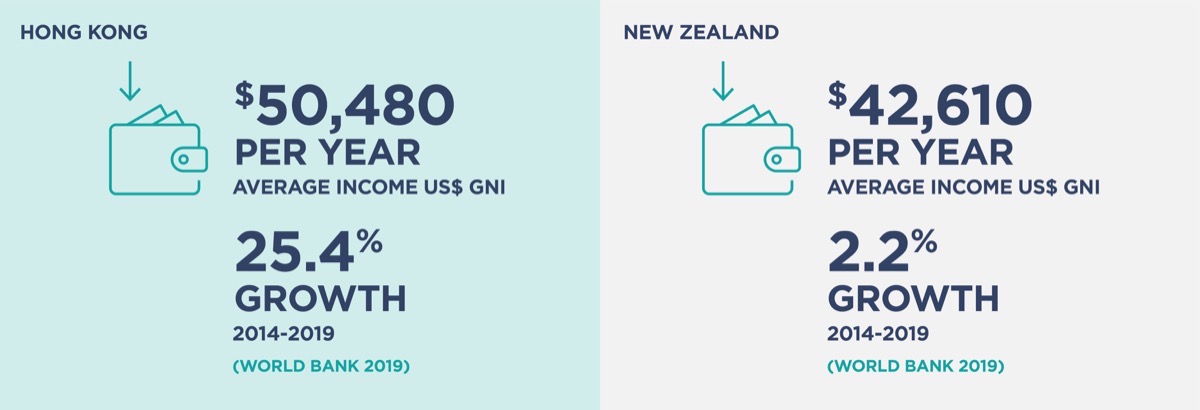
Annual Disposable Income refers to gross income minus social security contributions and income taxes. Each income band presents data referring to the percentage of households with a disposable income over that amount.
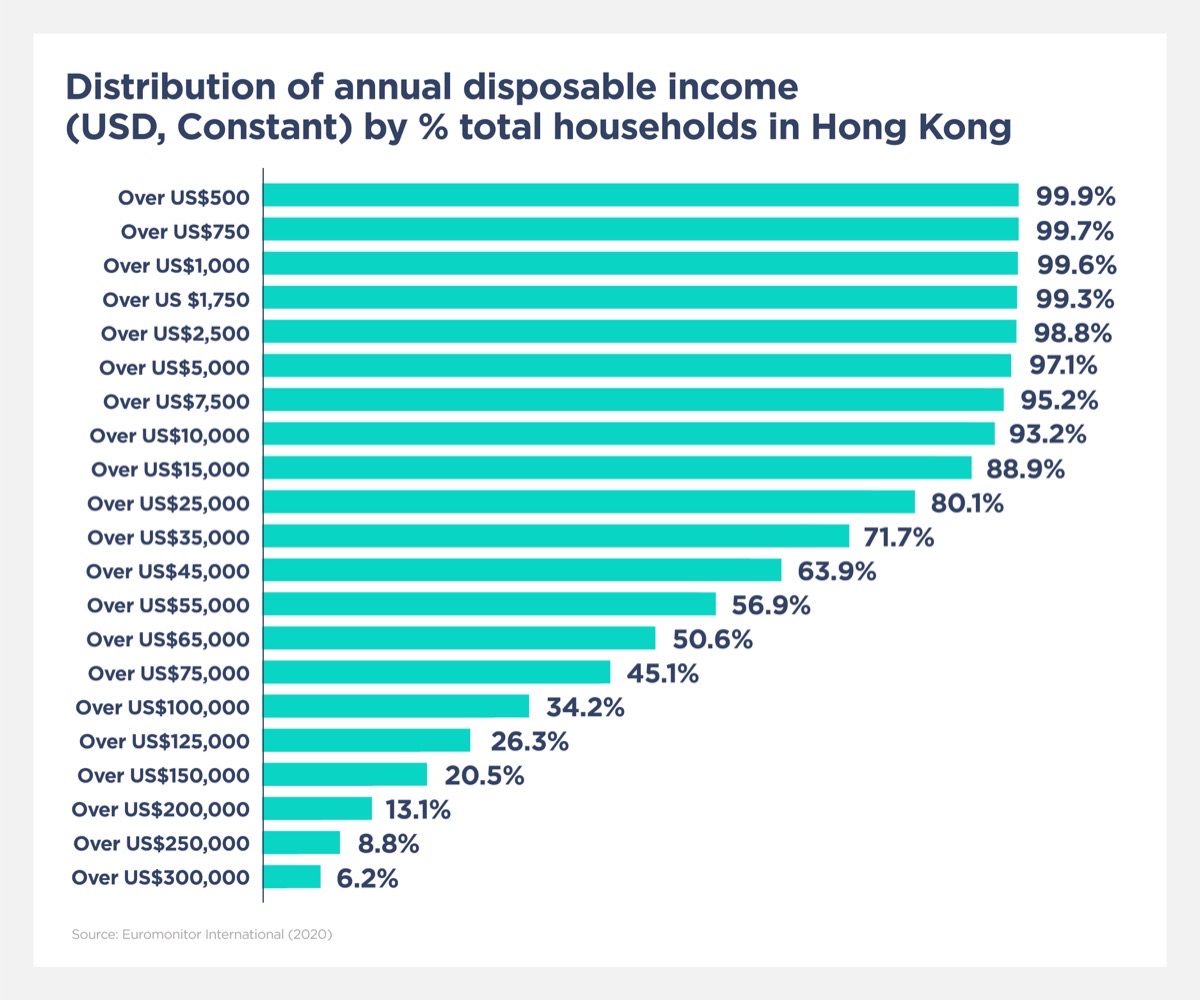
Further information
For more information to validate Hong Kong as an export market, see our Hong Kong Market Guide.
- Vitamins & Dietary Supplements
- Skin Care
- Dog & Cat Food
- Alcoholic Drinks
- Health & Wellness Packaged Food & Beverages
Vitamins & Dietary Supplements
- Market size and growth
-
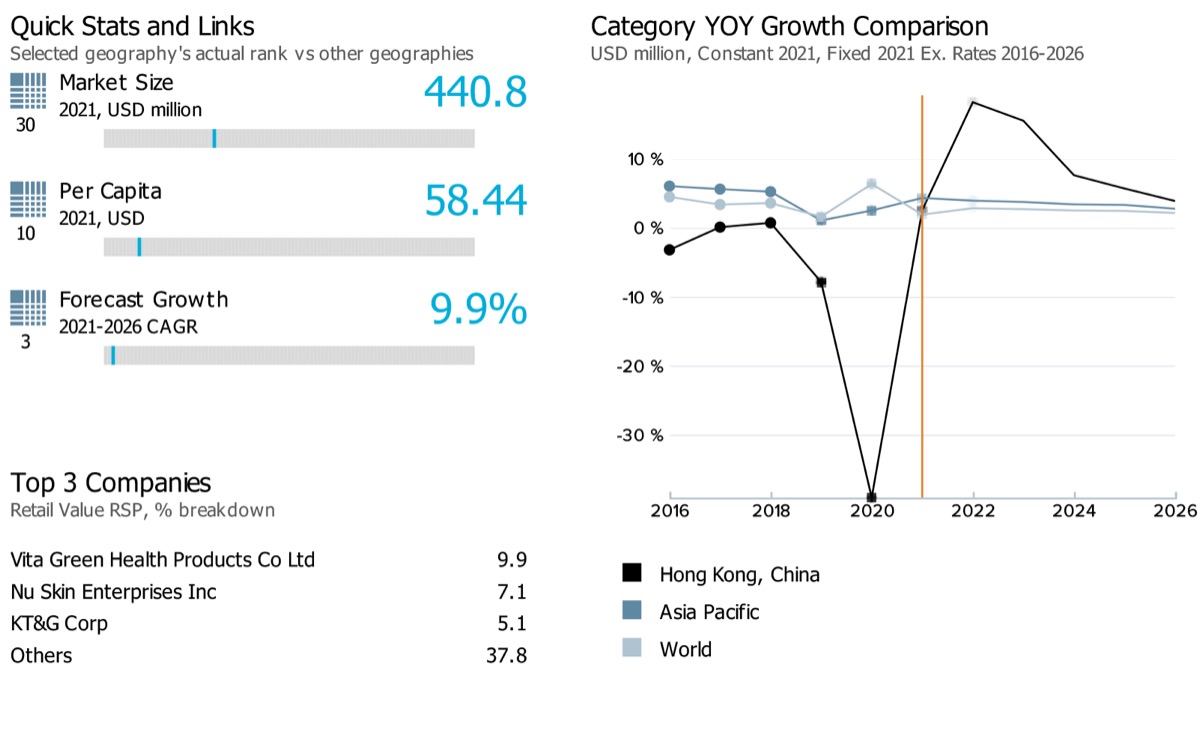
Note: Data on the top left corner of the image (30, 10 and 3) showcases respective ranks for Hong Kong for its market size, per capita, and forecast growth rate compared against 99 countries globally. The blue line on the grey bar represents the relative position of the country as per their rank.
Note: Latest market size data for the year 2021 has been shared for Vitamins & Dietary Supplements
Retail value sales of vitamins and dietary supplements in Hong Kong witnessed a historic compound annual growth (CAGR) of -8.9% during 2016-2021. It is further expected to grow strongly at a retail value CAGR of 9.9% during 2021-2026. At the global level, the category is estimated to slow down from a historic CAGR of 5.1% to a forecast CAGR of 2.4% over the same period for its retail value sales.
- Sub-category breakdown
-
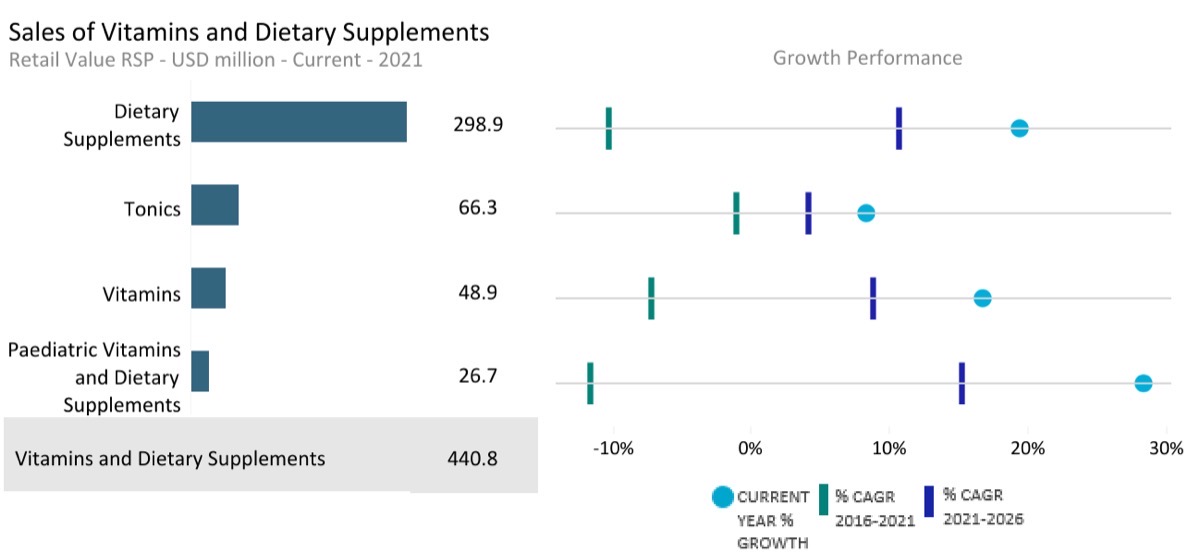
Note: Current year growth in the above chart refers to the period 2021-22
Category
Unit
Market size (2021)
Retail value RSP
Forecast compound annual growth rate (2021/2026) %
Vitamins and Dietary Supplements
USD million
440.77
9.88
Vitamins
USD million
48.95
8.79
Paediatric Vitamins and Dietary Supplements
USD million
26.66
15.20
Dietary Supplements
USD million
298.89
10.67
Tonics
USD million
66.27
4.10
- Channel distribution
-
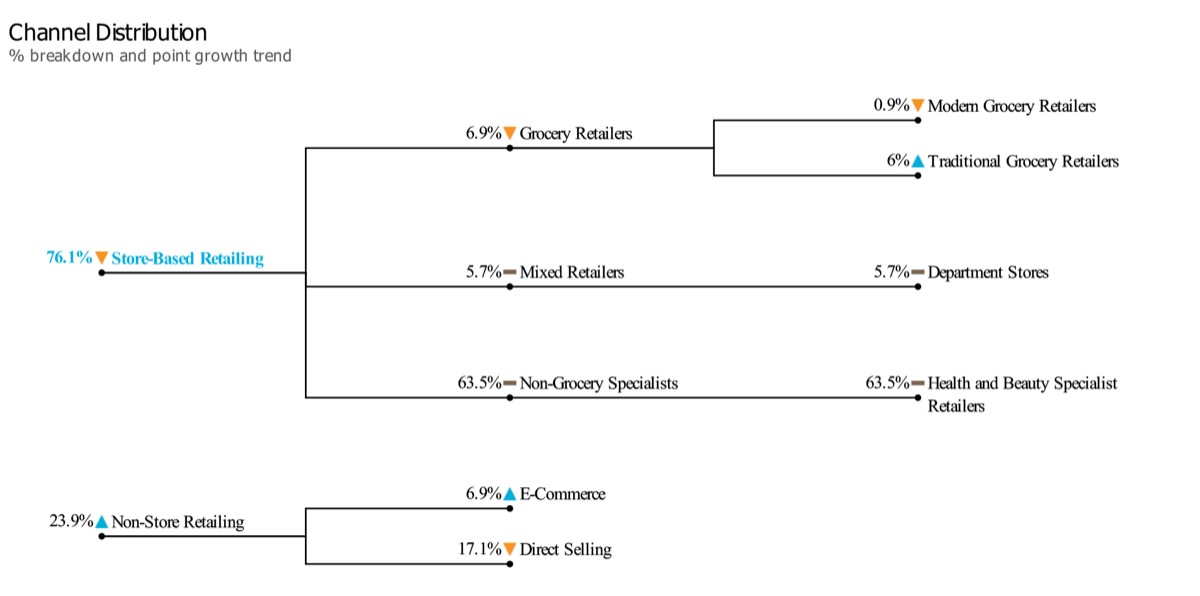
Note: The chart here showcases the retail value share of different channel sales for Vitamins and dietary supplement products in Hong Kong in 2021. The triangle/dash represents whether the specific channel share has increased/decreased or remained the same against its share in the previous year.
- Market Insights
-
Market trends
- Demand for vitamins witnessed a decline in retail value sales of 8% in 2020 because of the pandemic. Sales were largely lost by the lockdown of speciality stores followed by the permanent closure of some smaller stores. Also, the closure of the borders impacted the sales to some extent as vitamins are a key purchase for mainland Chinese tourists, However, in the entire category, Vitamin C remained the most resilient product type; due to its positioning as a preventative health product and its ability to fortify the immune system. Many consumers responded to the threat of COVID-19 by upping their intake of Vitamin C.
- On similar lines, dietary supplements suffered intensely from the impact of COVID-19 and particularly from border closures. Nevertheless, there remained some niche bright spots in the category. TCM (Traditional Chinese Medicine) ingredients such as Cordyceps, Ginseng and Lingzhi mushroom have enjoyed relatively stable sales among domestic customers as they shifted towards herbal options that they perceived to be milder and more natural. Echinacea and garlic also performed relatively well within the domestic market because consumers believe they help combat sickness and treat common colds. Vita Green led the category with a value share of 13% in 2020 due to its long heritage and well-established reputation locally.
Prospects and growth opportunity
- Vitamins are expected to show a fast rebound, with an expected retail value compound annual growth rate of 8.8% over 2021-2026. Multivitamins are expected to be among the categories leading the recovery, as they are expected to record growth among local and tourist demographics. As Hong Kong consumers tend to live a busy lifestyle, multivitamins play to their need for convenience, with one supplement tackling all nutritional requirements. Liquid formats are expected to be a notable growth area, led by the claim that the human body better absorbs them than pills or capsules. Brands such as H&H Group (Swisse) offer their vitamins in liquid format.
- For dietary supplements, the category is expected to become more segmented by functionality to quickly communicate its benefits to busy consumers and boost sales over the forecast period. When it comes to product communication, rather than classify supplements by the nature of ingredients, brands tend to categorise and position their dietary supplements by function. For example, GSK Consumer Healthcare (Caltrate), Vita Green Health Products Co Ltd (Doctor’s Choice) and Catalo offer different calcium supplement targets such as paediatric, early mature (30s) and senior (50s or above). Seventy percent of the population in Hong Kong is short-sighted and needs to wear glasses on a day-to-day basis. This is because of prolonged exposure to computer and TV screens. Therefore, eye health supplements are also forecasted to be a strong growth area.
General health & wellness trends
- Growth is also expected to be boosted by the development of new consumption occasions and broadening distribution, led by Japanese confectionery brands. Japanese brand UHA entered Hong Kong in 2019 with its gummy supplement range, sold through non-conventional channels such as supermarkets (Donki, Wellcome and ParknShop) and has repositioned supplements in a much broader sense, as a snack (two gummies to be taken per day). These supplement gummies include collagen, iron, folic acid and citric acid. Over the forecast period, it is expected that more supplements will be positioned in this format, and there will be a further blurring of the lines between confectionery, snacking and consumer health.
- Over the forecast period to 2025, vitamins from the online channel are anticipated to grow, driven by the increasingly higher acceptance of online purchases. With the popularity of the internet, consumers can effortlessly browse and select vitamins by their ingredient concentration, product format, origin, and price. International online operators, such as iherb, and local players, such as HKTVMall and Fingershopping, are popular online shopping platforms for vitamins.
Skin Care
- Market size and growth
-
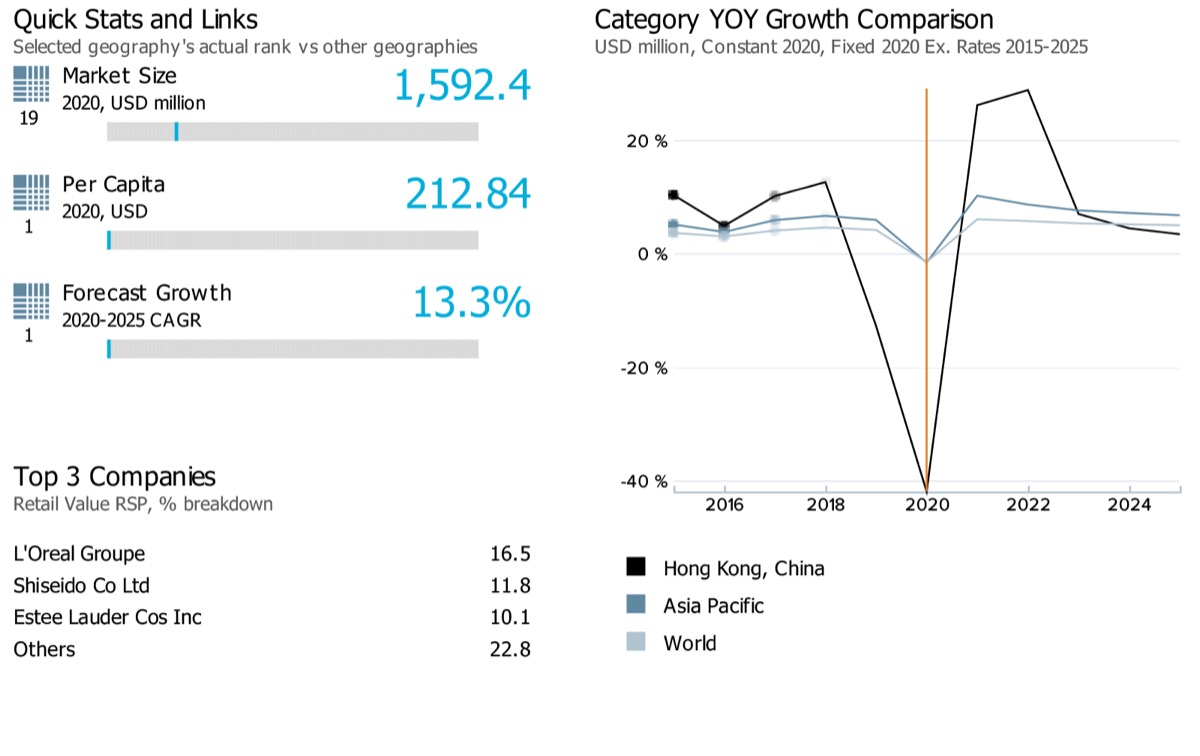
Note: Data on the top left corner of the image (19, 1 and 1) showcases respective ranks for Hong Kong for its market size, per capita, and forecast growth rate compared against 99 countries globally. The blue line on the grey bar represents the relative position of the country as per their rank.
Retail value sales of skin care products in Hong Kong witnessed a declining compound annual growth rate (CAGR) during 2015-2020 (-6.2%) against a strong category performance at a global level (4.7%) during the same period. However, over the forecast period (2020-2025), the category is estimated to witness an increased CAGR of 5.3% at the global level, while in Hong Kong, the category’s CAGR for the same time is estimated to rise strongly up to 13.3%.
- Sub-category breakdown
-
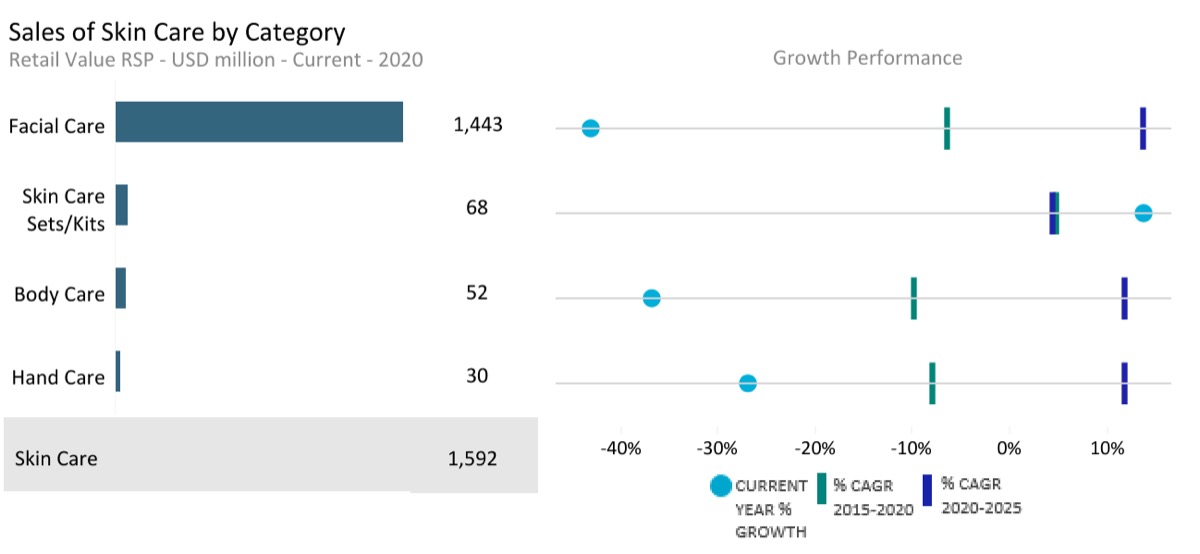
Note: Current year growth in the above chart refers to the period 2019-20
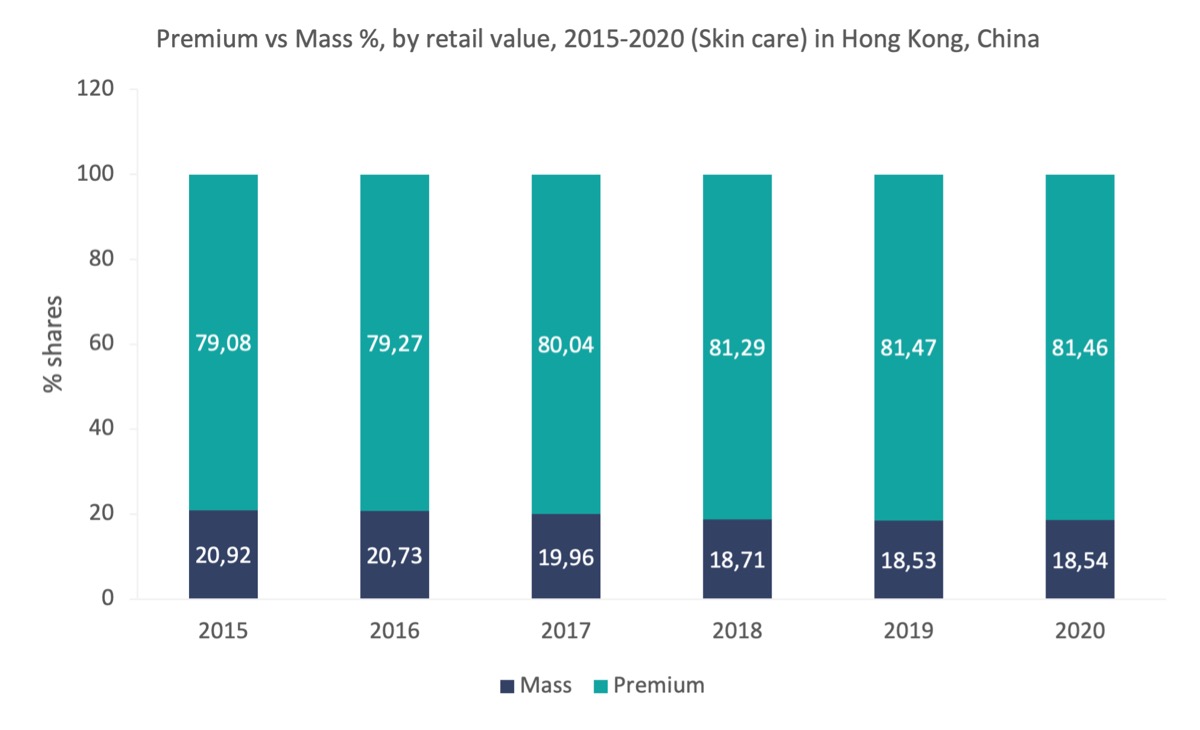
Category
Unit
Market size (2020)
Retail value RSP
Forecast compound annual growth rate (2020/2025) %
Skin Care
USD million
1,592.42
13.33
Body Care
USD million
51.98
11.83
Facial Care
USD million
1,442.92
13.76
Hand Care
USD million
29.82
11.96
Skin Care Sets/Kits
USD million
67.71
4.50
- Channel distribution
-
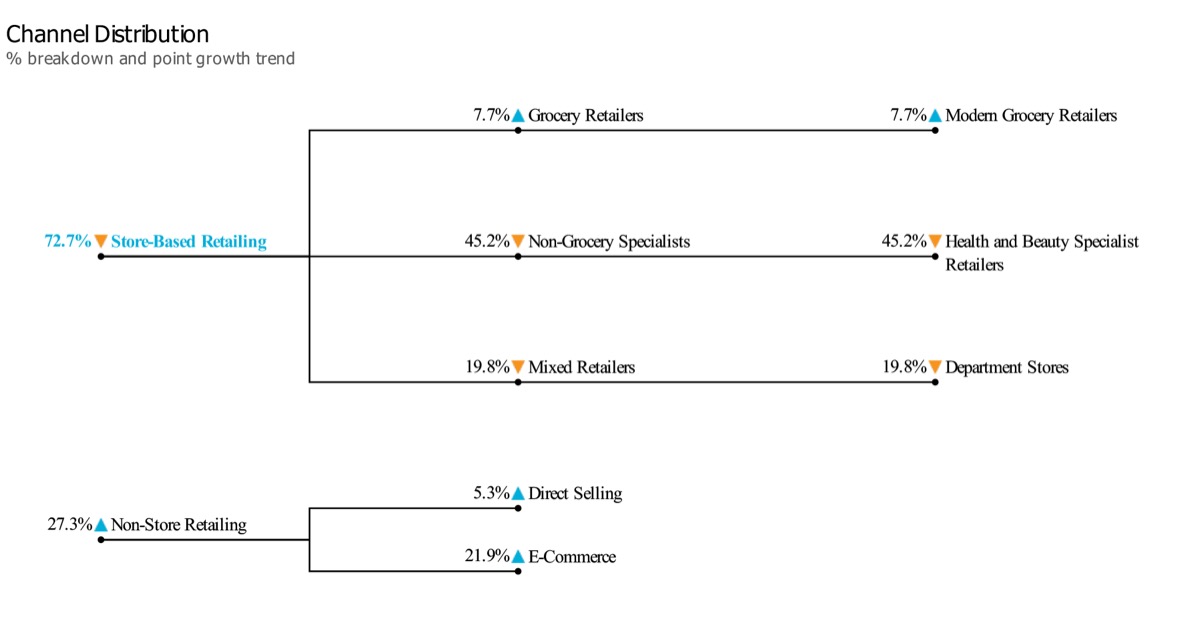
Note: The chart here showcases the retail value share of different channel sales for skin care products in Hong Kong in 2020. The triangle/dash represents whether the specific channel share has increased/decreased or remained the same against its share in the previous year.
- Market Insights
-
Market trends
- Skin care recorded a strong decline in retail value sales in the year 2020 (year on year growth rate:2019-2020: -41.4%). The reason for the sharp decline in retail value shares was the heavy reduction of retail tourism in 2020, as the COVID-19 pandemic necessitated border closures and travel restrictions. Overall, the number of tourists visiting Hong Kong in 2020 fell by 99%, which was particularly bad news for premium skin care brands that were popular before the COVID-19 crisis. L'Oréal remained the leader of skin care in 2020 due to its strong brand portfolio, including well-known brands such as Lancôme, Kiehl's and SkinCeuticals. These brands benefited from L'Oréal's active online expansion in 2020, as well as the continued cultivation of brand loyalty which was strong amongst local consumers before the outbreak of the COVID-19 pandemic.
- The clean beauty trend continued to gain traction in Hong Kong in 2020, boosted by the emergence of maskne during the pandemic. This led to an increase, especially in mass skin care products, as the range of clean beauty brands in Hong Kong continued to grow in 2020. Skin care retailer Mi Ming Mart, a leader in clean beauty brands in Hong Kong thanks to its rigorous in-house standard on the classification of clean ingredients, benefited from this trend. Due to the strong emergence of this trend during the COVID-19 crisis, multiple skin care retailers in Hong Kong increased their focus on clean beauty products, positioning them as solutions to maskne. Sasa and Watsons, for instance, began to actively market and promote clean beauty products with a focus on products with calming and soothing effects.
- During the COVID-19 pandemic, players in skin care ramped up their digital marketing to develop stronger brand engagement online and attract new, especially younger, customers. This was particularly noticeable amongst premium brands. Fresh, for example, launched several key live-streaming events in 2020, collaborating with popular make-up, lifestyle and skin care influencers to boost online engagement. Beyond the emergence of livestreaming, many premium brands have also invested in expanding their e-commerce offerings in 2020 by developing permanent or pop-up e-commerce stores. Chanel and Hermès, for instance, used online pop-up stores in 2020 to boost e-commerce sales. Other premium and prestige skin care brands stimulated sales by offering heavy discounts on their products or offering extra rewards for giveaways.
Prospects and growth opportunity
- From 2021, skin care's prospects are projected to improve rapidly, with particularly strong retail current value growth projected for 2021 and 2022. This is due to the resumption of international travel, the return of retail tourism to the region, and the continued momentum in local demand as the self-care trend seems here to stay in Hong Kong. The category is also expected to benefit from the premiumisation trend over the forecast period, which will support retail current value growth as consumers will be more willing to invest in premium and prestige brands like Tatcha, Pola and Decorte, and especially those backed by science and technology. Established brands such as Shiseido and Clé de Peau Beauté will continue to register strong growth in the forecast period thanks to their strong brand images as effective products backed by science.
- Probiotics are expected to become a popular ingredient in skin care products in the coming years as an immunity booster, following probiotics' success in consumer health products. Mass and premium brands alike are expected to introduce probiotics into their product formulae in the coming years. Korres, a Greek skin care brand that focuses on probiotics for the skin, is being introduced to Mannings (beauty and personal care product chain) and HKTV (Hong Kong Technology Venture Company Limited - a Hong Kong-based technology company, primarily known for its e-commerce platform), marking the introduction of probiotics products in Hong Kong, with other brands and products expected to emerge in the forecast period. Too Faced, for instance, a colour cosmetics brand, has also launched a heated moisturiser that highlights the incorporation of probiotics that help to boost skin immunity.
General health & wellness trends
- Thanks to the rise in skin care online influencers, consumers in Hong Kong are becoming increasingly informed about the ingredients used in skin care products. In the forecast period, brands will continue to use this strategy, appealing to consumers by naming their products after their active ingredients and using plain bottles that appear more clinical. Brands such as SkinCeuticals and Augustinus Bader are expected to benefit from this trend in coming years thanks to their clinical brand positioning and the strong backing of scientific formulae.
- The skinification trend (focus on skin care benefits in categories other than skin care) is expected to intensify as a result of the growing importance of skin care to Hong Kong consumers, which has been accelerated by the emergence of maskne (acne linked to wearing face masks) during the COVID-19 pandemic. The self-care trend is also expected to boost skinification in categories such as hair care, oral care, colour cosmetics and sun care, as products with skin care properties are perceived as soothing. Therefore, products targeting personal, physical and mental well-being will gain considerable momentum in Hong Kong over the forecast period to 2025.
Dog & Cat Food
- Market size and growth
-
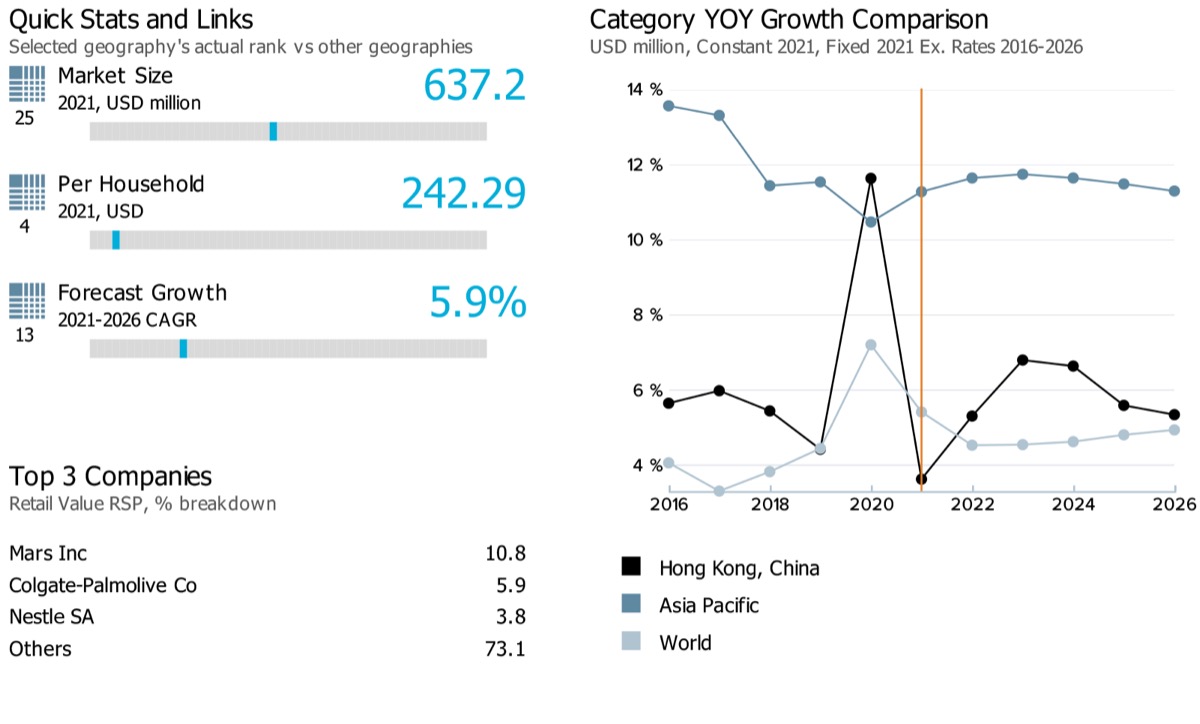
Note: Data on the top left corner of the image (25, 4 and 13) showcases respective ranks for Hong Kong for its market size, per capita, and forecast growth rate compared against 53 countries globally. The blue line on the grey bar represents the relative position of the country as per their rank.
Note: Latest market size data for the year 2021 has been shared for Dog and Cat food
Performance of retail value sales of dog and cat food in Hong Kong is estimated to slow down from historic compound annual growth rate (CAGR) of 8.0% during 2016-2021 to an estimated forecast CAGR of 5.9% over 2021-2026. The category’s performance in the country has been slightly stronger than its global performance. Globally, the category witnessed a historic CAGR of 6.9% and an estimated forecast CAGR of 4.7% during the same period.
- Sub-category breakdown
-
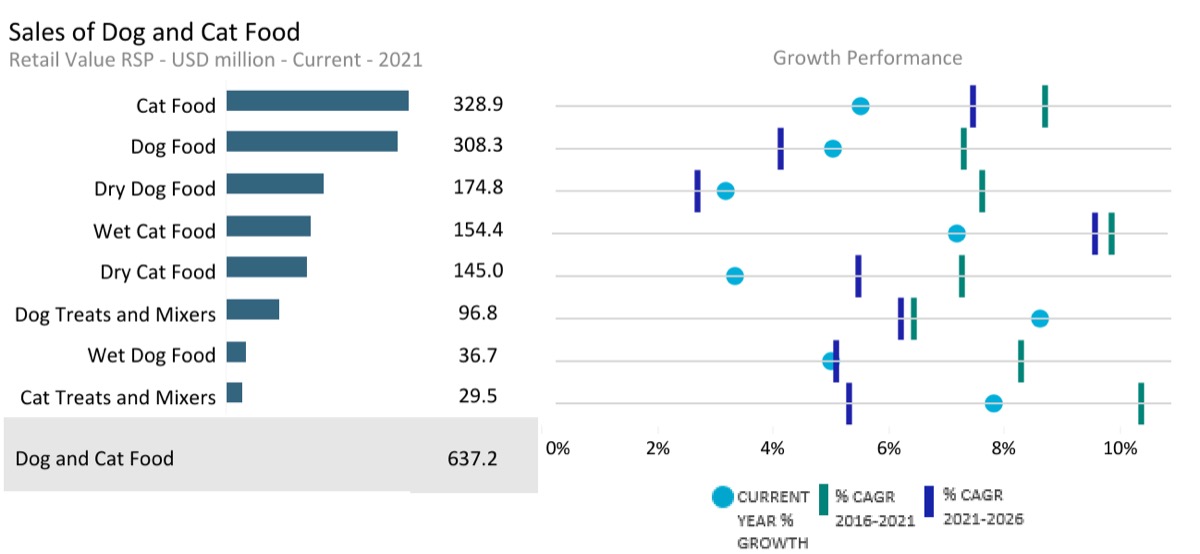
Note: Current year growth in the above chart refers to the period 2020-21
Category
Unit
Market size (2021)
Retail value RSP
Forecast compound annual growth rate (2021/2026) %
Dog and Cat Food
USD million
637.19
5.91
Dog Food
USD million
308.30
4.14
Dog Treats and Mixers
USD million
96.80
6.23
Dry Dog Food
USD million
174.80
2.69
Wet Dog Food
USD million
36.69
5.09
Cat Food
USD million
328.89
7.46
Wet Cat Food
USD million
154.37
9.57
Dry Cat Food
USD million
145.01
5.48
Cat treats and mixers
USD million
29.51
5.33
- Channel distribution
-
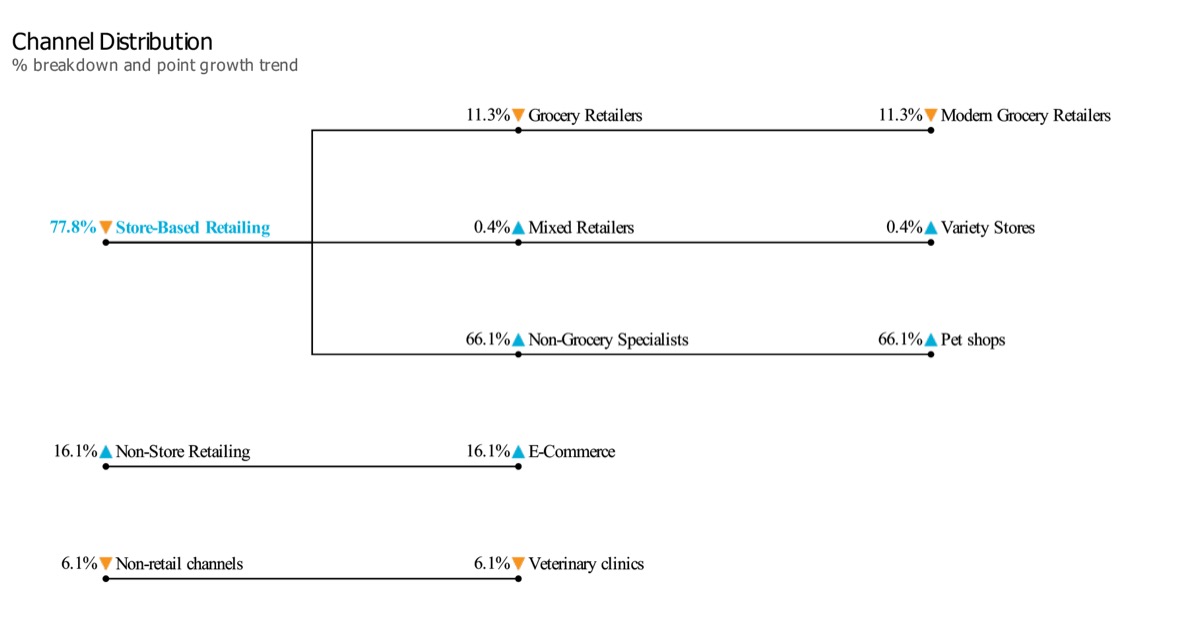
Note: The chart here showcases the retail value share of different channel sales for dog and cat food products in Hong Kong in 2021. The triangle/dash represents whether the specific channel share has increased/decreased or remained the same against its share in the previous year.
- Market Insights
-
Market trends
- The dog population in Hong Kong grew considerably in 2020 during the COVID-19 pandemic, supporting growth in dog food sales in 2021. Pet ownership increased again in 2021, as the COVID-19 reversed the decline in dog ownership experienced in 2018 and again in 2019. Despite a sharp rise in dog ownership in 2020, dog food was not subject to the same premiumisation trend as cat food. The lack of premiumisation in dog food compared to cat food is due to the fact that dog food was constrained by a wider socioeconomic range amongst dog owners in Hong Kong. Instead of merely pursuing high protein dog food products, consumers are expected to pay more attention to the wider nutritional content and ingredients contained in dog food products in the forecasted period. Royal Canin, owned by the category leader Mars Hong Kong recommended the pet owners to use customised products containing the recommended nutritional content for dogs based on their breed, size, age, weight, digestion, and even genetic make-up.
- The cat population in Hong Kong grew considerably in 2020 as a result of the loneliness of home seclusion following the outbreak of the COVID-19 pandemic. Cat food is seeing the rise of the fortification trend, with health and wellness claims such as vitamin content, omega 3 content, and ingredients that support digestive health particularly well received by consumers in Hong Kong. Sheba by Mars Hong Kong Ltd and Mon Petit by Nestlé Hong Kong Ltd continue to compete hard for customers in cat food, but both will continue to record a strong performance in supermarkets in 2021 thanks to new product launches.
Prospects and growth opportunity
- As consumers become more aware of the varied nutritional needs of different dog breeds, there will be more competition in the customised nutrition plan sector of dog food over the forecast period. Nestlé Hong Kong Ltd’s Pro Plan brand launched its first-ever prescription diet in Hong Kong with help from the rapidly growing distributor Kangaroo Pet Nutrition Ltd. Meanwhile, the niche segments of fresh-made and raw pet food are also expected to rise among highly sophisticated pet owners over the forecast period. Supermarket chains such as those owned by the A.S. Watson Group are expected to source a growing range of premium brands over the forecast period to 2026, such as Lily’s Kitchen, SmartHeart Gold, and Pronature, to appeal to the premiumisation trend in pet care and to remain competitive with other retailers.
- Owners’ sophistication in cat food selection and desire for complete nutrition is constantly rising in Hong Kong. Apart from basic practices such as adopting a blend of dry and wet cat food, owners’ preference is leaning towards authentic meat in the search for a high protein and low carbohydrate diet. Premium meat offerings such as free-range, grass-fed New Zealand lamb become highlighted attributes for high-end cat food players. Air-dried jerky and freeze-dried cat food, with high raw meat composition and most nutrition of meat retained, will continue to hit the shelves over the forecast period to 2026.
General health & wellness trends
- E-commerce was the biggest winner of the COVID-19 pandemic, recording a considerable increase in dog food's value share in 2020 and subsequently retaining this strong value share in 2021. Furthermore, in 2021 and throughout the forecast period (2021-2026), many of the consumers will continue to use e-commerce thanks to the convenience and ease of use that e-commerce sales offer.
- In addition, there has been an increase in the number of vets' clinics in 2021 as new pet dogs need to be vaccinated. This surge in new vets also presents new opportunities for sales of dog food in Hong Kong.
- Pure vegetarianism in cat food is fading away. This is interestingly in contrast to the growing popularity of vegetarianism and veganism in human food. Vegetarian cat food is more positioned as a diet complement, so players are expected to rely more on attitudinal brandings, such as emphasising no harm to other animals, conservation of source habitats and reduced carbon footprint to capture consumers' loyalty and purchase.
Alcoholic Drinks
- Market size and growth
-
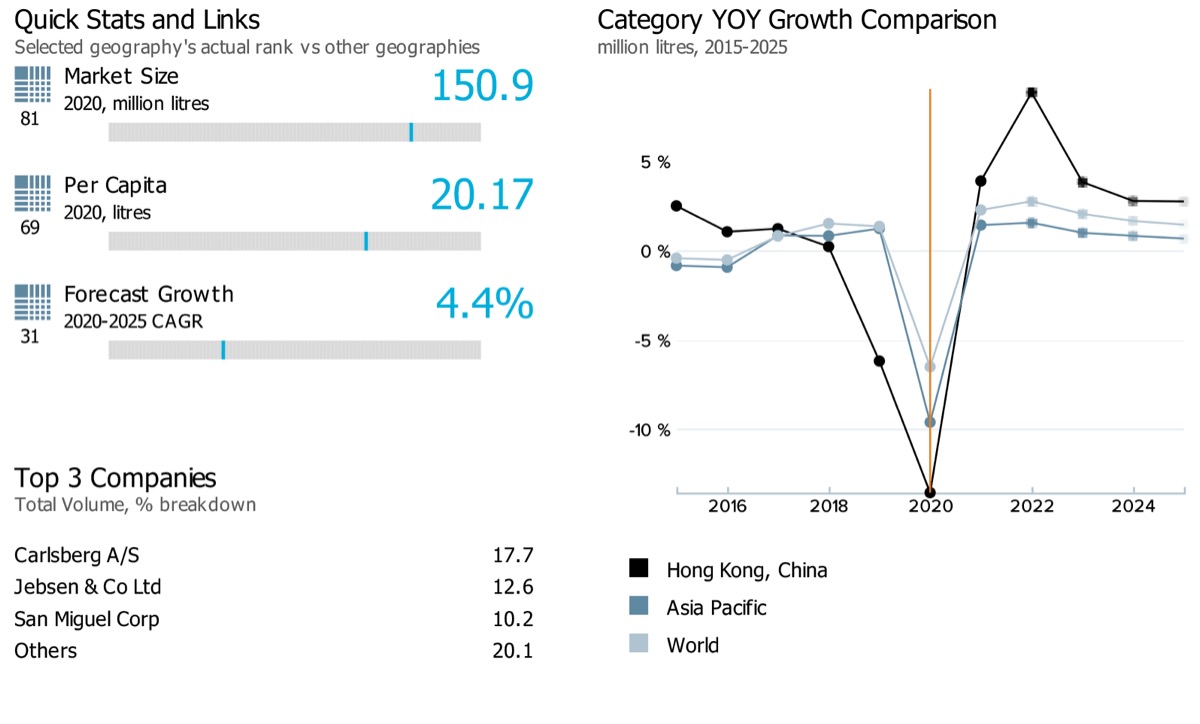
Note: Market size data for the alcoholic drinks category in the country reflects the total volume in million litres. Data on the top left corner of the image (81, 69 and 31) showcases respective ranks for Hong Kong for its market size, per capita, and forecast growth rate compared against 99 countries globally. The blue line on the grey bar represents the relative position of the country as per their rank.
The compound annual growth rate (CAGR) for alcoholic drinks in Hong Kong, both in terms of total value and volume, is expected to gain momentum over the forecast period (2020-2025: FCAGR for total value: 7.8% and for total volume: 4.4% ) against its performance in the historic period (2015-2020: HCAGR for total value: -7.9% and for total volume: -3.7% ). This is largely in line with the category’s performance at the global level, where both in terms of total value and volume, alcoholic drinks are expected to gain momentum over the forecast period (2020-2025: FCAGR for total value: 4.6% and for total volume: 2.0% ) against its performance in the historic period (2015-2020: HCAGR for total value: 0.9% and for total volume: -0.7%)
- Sub-category breakdown
-
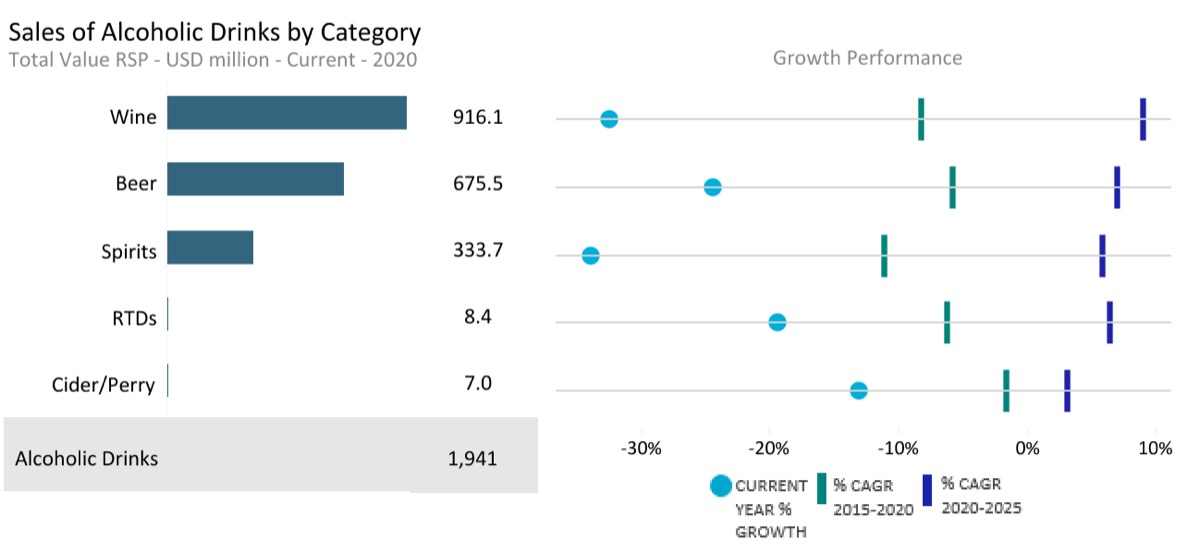
Current year growth in the above chart refers to the period 2019-20
Category
Data type
Market size (2020)
USD million
Forecast compound annual growth rate (2020/2025) %
Alcoholic Drinks
Total Value RSP
1,940.70
7.77
Alcoholic Drinks
Off-trade Value RSP
985.04
5.32
Alcoholic Drinks
On-trade Value RSP
955.67
10.07
Beer
Total Value RSP
675.53
7.01
Beer
Off-trade Value RSP
406.53
5.08
Beer
On-trade Value RSP
268.99
9.69
Cider/Perry
Total Value RSP
6.96
3.06
Cider/Perry
Off-trade Value RSP
5.26
1.96
Cider/Perry
On-trade Value RSP
1.70
6.19
RTDs
Total Value RSP
8.41
6.41
RTDs
Off-trade Value RSP
6.66
6.49
RTDs
On-trade Value RSP
1.75
6.09
Spirits
Total Value RSP
333.68
5.91
Spirits
Off-trade Value RSP
148.26
4.89
Spirits
On-trade Value RSP
185.41
6.69
Wine
Total Value RSP
916.13
8.99
Wine
Off-trade Value RSP
418.33
5.74
Wine
On-trade Value RSP
497.79
11.45
- Channel distribution
-
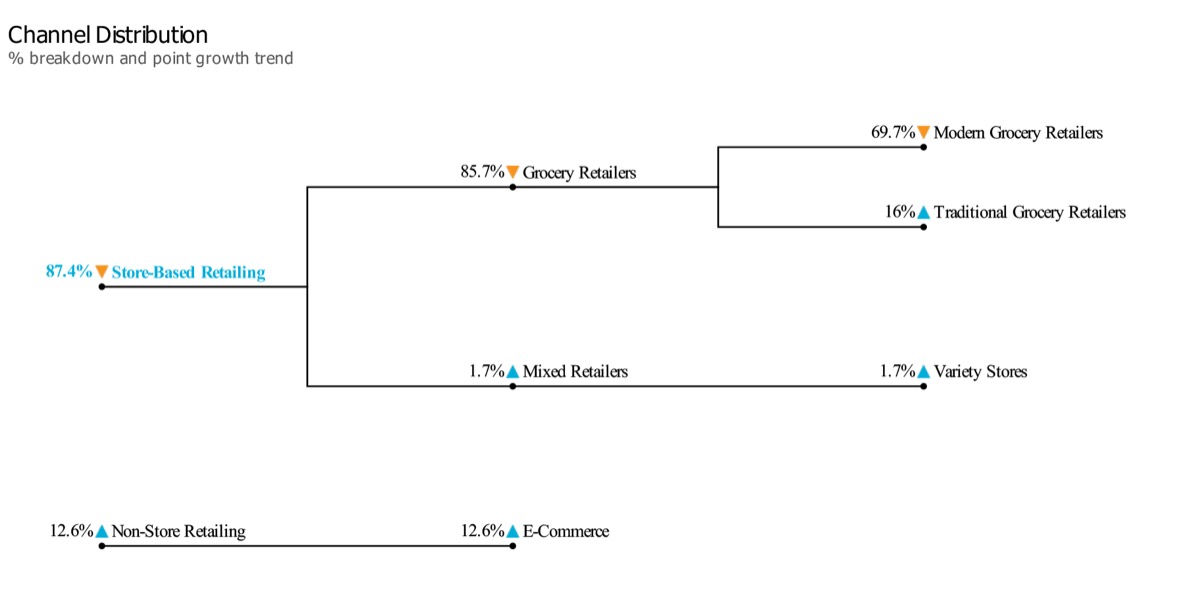
Note: The chart here showcases the off-trade volume share of different channel sales for alcoholic drink products in Hong Kong in 2020. The triangle/dash represents whether the specific channel share has increased/decreased or remained the same against its share in the previous year.
- Market Insights
-
Market trends
- COVID-19 had a huge impact on alcoholic drinks in Hong Kong, China. Overall, total volume sales of alcoholic drinks suffered a significant decline of 13.6% in 2020. The reasons can be associated to a major sales slump in foodservice, because of the lockdown measures introduced by the government. On the other hand, even when foodservice outlets were allowed to open, strict restrictions were in place on the number of customers allowed indoors. As a result, even when on-premises were open, businesses could not operate at full capacity. Given some consumers worked from home for much of 2020, their alcohol consumption shifted from the on-trade to the off-trade and from bars to homes, boosting retail sales of alcoholic drinks. However, the boost to retail sales was insufficient to compensate for the devastating losses in on-trade volume sales.
- Total volume sales of beer slumped by -11.8% in 2020 as a direct result of the COVID-19 pandemic. Commercial and mainstream beer was hit hardest by the pandemic, as these types of beer normally enjoy strong sales within foodservice channels. In the past year, some consumers continued to switch to craft beer in a search for new experiences and more sophisticated tastes. Also, these players continued to launch new products, focusing on quality. For example, given the continued growth potential of these products, Young Master launched several new flavours, including Double Haven, produced in a craft beer brewery that previously produced craft beer for other brands such as HK YAU by Carlsberg Brewery Hong Kong.
- Brandy and Cognac are increasingly suffering from a perception of being old-fashioned, while the reductions in on-trade drinking occasions and mainland tourists also contributed to the sharp decline of these drinks in 2020. Tourists from mainland China frequently purchased brandy and cognac for their consumption and gift purposes, which contributed enormously to sales. However, the border closure between Hong Kong, China and the mainland due to the pandemic resulted in a sharp decline in mainland tourist numbers, which contributed to the declines in sales of brandy and Cognac.
Prospects and growth opportunity
- Overall beer sales are predicted to witness stable growth over the 2023-2025 period, gradually recovering from the impacts of COVID-19, as consumers in Hong Kong, China will be keen to socialise with their friends again in bars and pubs. Craft and non-alcoholic beer will continue to become more popular, supporting overall growth due to increasing sophistication among consumers for craft beer and active marketing by manufacturers for non-alcoholic beer. Despite the pandemic, Carlsberg Brewery Hong Kong and Jebsen & Co remained the two largest beer companies in Hong Kong, China, by total volume share in 2020, and the competitive landscape is unlikely to change over the forecast period.
- Spirits are expected to return to strong total volume growth as early as 2021, with good development over the remainder of the forecast period. The whisky culture is strong in Hong Kong, China, and the spirit performed well in retail channels during the crisis as consumers had more time and money to explore the different types of whisky. Premium whiskies such as single malt Scotch whisky and Japanese whisky will continue to attract consumer interest due to the trend towards greater sophistication which is evident across alcoholic drinks. However, rum has remained somewhat of a niche, and it is unlikely to take off as rum manufacturers are not investing enough to promote the product among consumers. Only one large player in rum, Bacardi-Martini Asia Pacific, has been working hard on consumer education, but this has not been enough to produce a breakthrough.
General industry trends
- In the long run, craft beer will continue growing and take a substantial share of the overall beer area, as it has done in the US. To achieve this goal, craft beer companies will continue to increase consumer awareness and build the emotional connection between craft beer brands and consumers. In doing so, players will take advantage of funding from the HONG Kong Craft Beer association to improve customer education around the beverage.
- Beer companies continue to view non-alcoholic beer as a new opportunity to extend usage occasions and to attract female and non-beer drinkers to beer. Given the proven success of Carlsberg 0% in alcohol-free beer, it is likely that other beer companies will continue to add similar products to their existing product portfolios of non-alcoholic beer to create new opportunities for sales.
Health & Wellness Packaged Food & Beverages
- Market size and growth
-
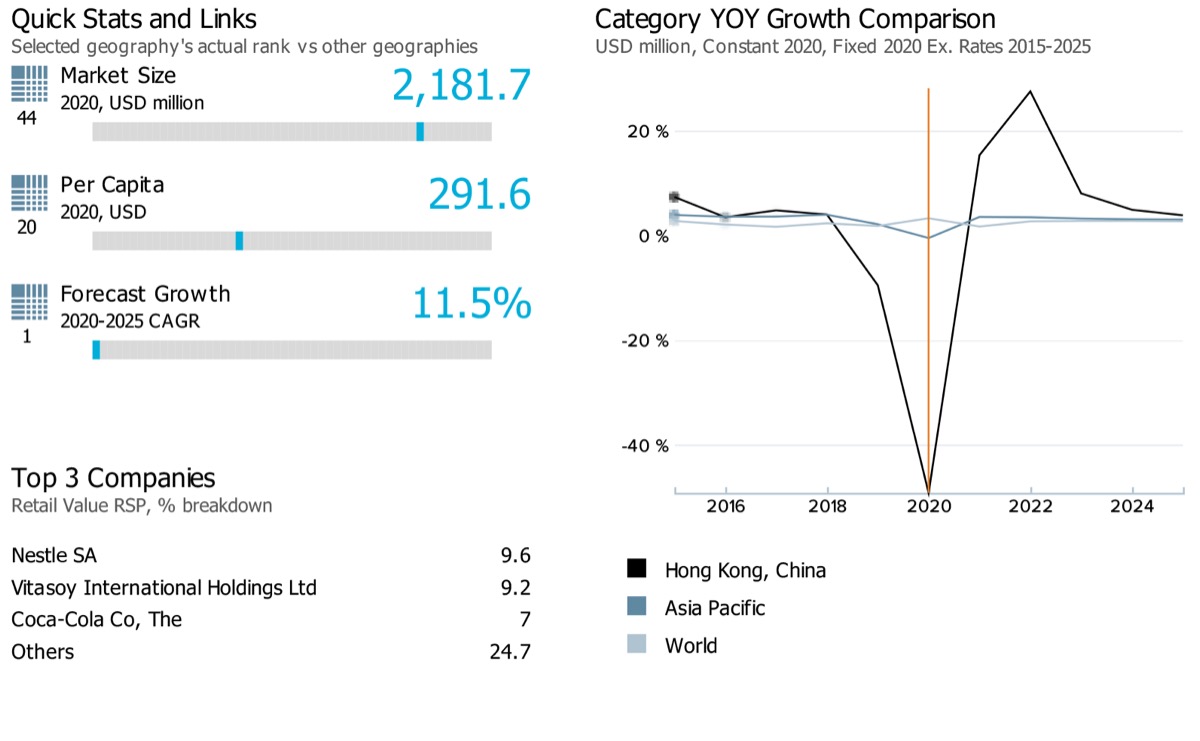
Note: Data on the top left corner of the image (44, 20 and 1) showcases respective ranks for Hong Kong for its market size, per capita, and forecast growth rate compared against 53 countries globally. The blue line on the grey bar represents the relative position of the country as per their rank.
The retail value sales of health and wellness food and beverage products in Hong Kong are expected to witness a strong growth rate when comparing the compound annual growth rates from historic to forecast periods, i.e. (-10.4% during 2015-2020 to 11.5% during 2020-2025). However, at the global level, the category is estimated to witness a slowdown in its compound annual growth rate for retail value sales from 4.6% during 2015-2020 to 2.4% during 2020-2025.
- Sub-category breakdown
-
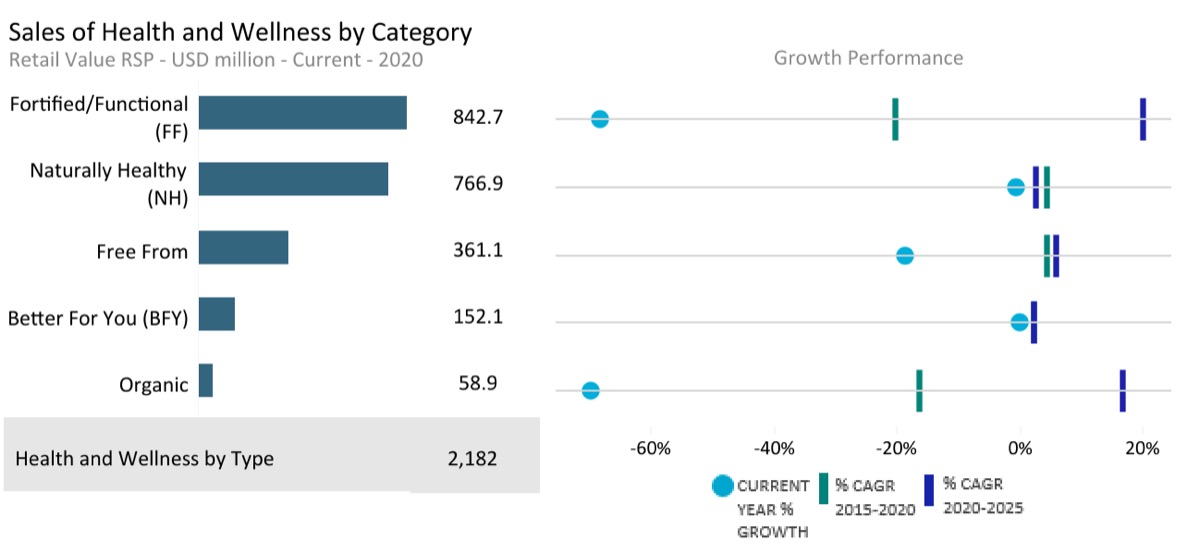
Current year growth in the above chart refers to the period 2019-20
Category
Unit
Market size (2020)
Retail value RSP
Forecast compound annual growth rate (2020/2025) %
Health and Wellness by Type
USD million
2,181.69
11.51
Better For You (BFY)
USD million
152.09
2.39
Fortified/Functional (FF)
USD million
842.68
20.02
Free From
USD million
361.13
6.02
Naturally Healthy (NH)
USD million
766.87
2.77
Organic
USD million
58.93
16.87
- Channel distribution
-
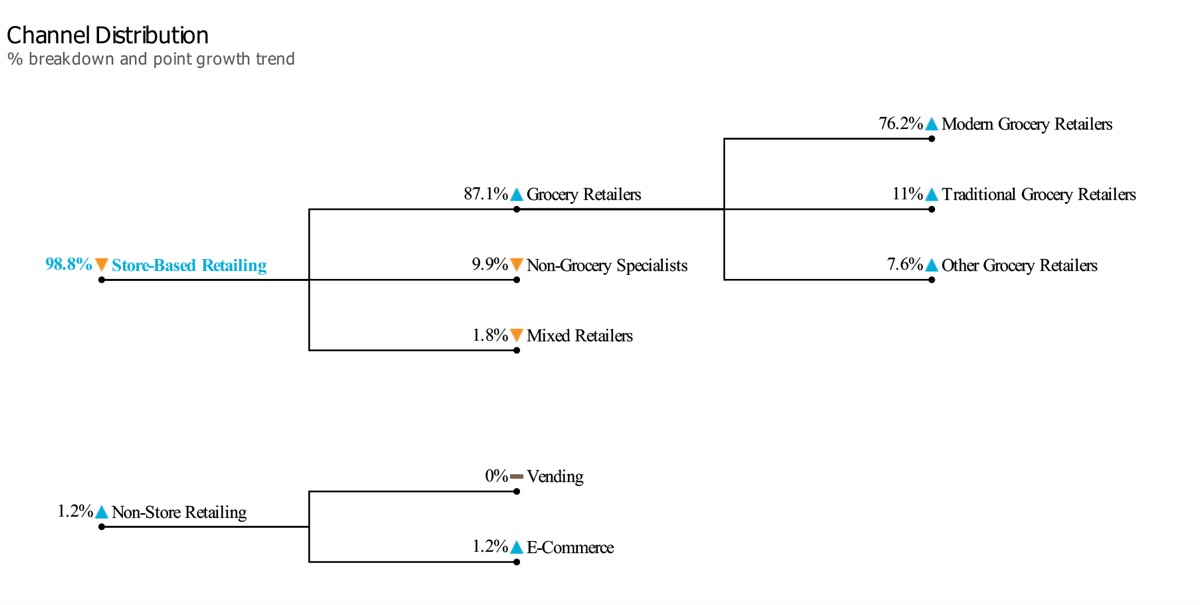
Note: The chart here showcases the retail value share of different channel sales for health and wellness by type products in Hong Kong in 2020. The triangle/dash represents whether the specific channel share has increased/decreased or remained the same against its share in the previous year.
- Market Insights
-
Market trends
- Driven by the global health and wellness trend, Hong Kong consumers have been increasingly focusing on their physical and mental health and wellbeing. This has created a consistent demand for all health and wellness products as part of a lifestyle change, with gym classes, for example, booming in the city prior to the pandemic. Consumers now are ever warier about their sugar intake. This favours demand for BFY (better for you) beverages as they are typically positioned with a reduced or no sugar content. In general, sales for health and wellness beverages in 2020 declined due to the much-diminished opportunity for impulse purchases. Most consumers spend much more time at home than on the go.
- During the review period, FF (fortified/functional) energy drinks experienced respectable growth in value and volume off-trade sales due to the beverages’ mental-boosting and invigorating properties. Meanwhile, FF sports drinks in Hong Kong have continued to benefit from the health and wellness trend as the number of consumers taking part in sports, and physical activity has kept growing. Because consumers are increasingly favouring products with fortified/functional claims, non-alcoholic drinks companies are responding by continually seeking to supplement their product offerings with health-beneficial properties. Also, in FF bottled water, Watson’s private label introduced its new SKU Alkaline Water 9.0 in 2019, offering still natural mineral bottled water electrolysed by platinised titanium ioniser, expanding its already existing wide product range in the category during the review period.
- After several years of positive performance, volume sales of NH (naturally healthy) beverages dipped in 2020 because of home seclusion following the outbreak of COVID-19. Many consumers prioritised bulk purchases of beverages or bought units with larger quantities, mindful of extended time spent at home and wishing to avoid unnecessary repeat trips to stores. This did not favour NH beverages, which are more associated with smaller units for portable consumption while out and about. Within NH hot drinks, NH fruit/herbal tea recorded the most dynamic growth in retail value terms in 2020. In addition, new products centred on health claims are constantly launched in Hong Kong, such as Tea Art Fitness Tea. It is likely that NH fruit/herbal tea will become more significant in the market over the forecast period (2020-2025), given the strengthening and increasing segmentation of the health and wellness trend.
Prospects and growth opportunity
- Complete recovery in volume sales for FF beverages is expected by the end of 2022 when units sold should return to 2019 levels. FF sports drinks will strengthen its dominance of volume sales by 2025, with it likely posting the highest CAGR within FF beverages over the forecast period. Despite the fact FF sports drinks is a consolidated category dominated by Otsuka, the ongoing entry of new players and products will make the landscape more competitive. It is expected that there will be more new brands entering FF sports drinks due to the rising interest in exercise and sport among consumers over the forecast period. While big brands that are already established will try their best to defend their territories to maximise their share, new and small players will also amass share as the consumer base grows.
- NH (naturally healthy) beverages is expected to return to volume growth in 2021, and sales will likely reach pre-pandemic levels in 2022. NH RTD tea is likely to perform well in the forecast period to 2025, especially NH RTD green tea, which is set to post the strongest growth rate as health consciousness expands faster-considering COVID-19. International brands with a wide range of tea varieties are increasingly popular among younger consumers, capturing their attention. Brands such as Taylors and Twinings have offerings such as Darjeeling, Green Tea and Earl Grey, which have dominated in Hong Kong, and their popularity is still rising.
General health & wellness trends
- To compensate for the unhealthy lifestyle that people would eventually resort to after returning to a normal schedule and busy working life, health and wellness are likely to become a more significant consideration for more people, boosting sales in the market throughout the forecast period (2020-2025). Continual efforts by the government of Hong Kong to educate the population about the importance of healthy dietary habits and the appearance of new products with multi-faceted benefits are also likely to contribute to this shift. Growing awareness of food safety issues is also set to continue supporting growth in sales of organic products. In addition, population ageing is set to drive demand for FF food and beverages, which offer many benefits related to ageing, including bone and joint health and energy-boosting.
- Western players are competing in NH bottled water in Hong Kong. Both popular players and small players can be found easily in the market, and there was a wide variety of offerings in terms of water sources and segments among these Western companies and their brands. For example, sales leader Evian offers consumers a taste of French still natural mineral water, while Highland Spring provides consumers with the flavours of Scottish carbonated spring bottled water. Having all these imported options available is attractive to consumers and provides a platform for experimentation and premiumisation over the forecast period. This interest as well as the health appeal will help keep NH bottled water leading overall sales in the long term and among the categories with the fastest growth rates over the forecast period.
Retail Landscape
- Brand shares of supermarkets
-
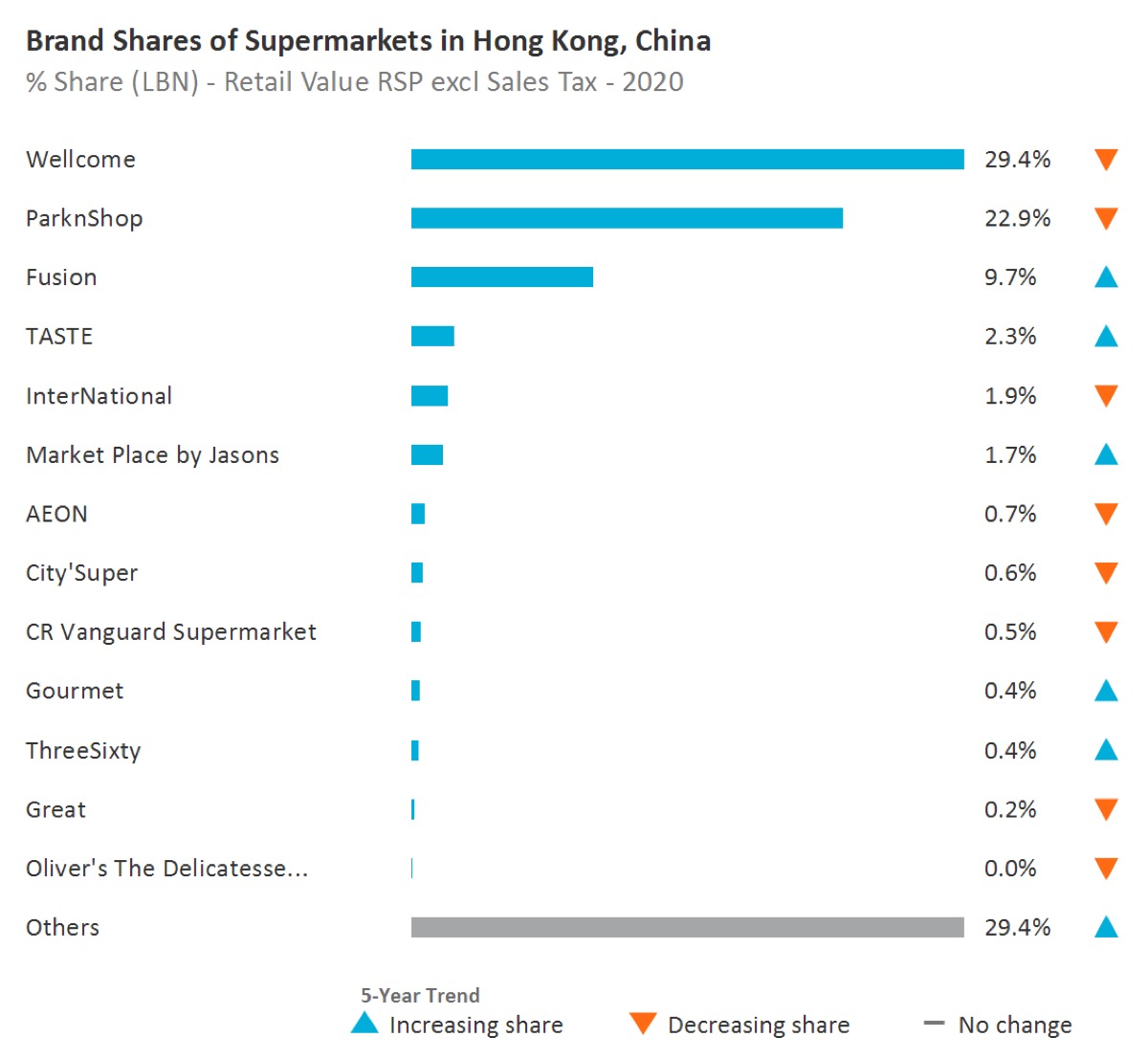
Note: The 13th supermarket in the above chart is – Oliver’s The Delicatessen
- Brand shares of chemists/pharmacies
-
No data available
- Retail insights
-
- COVID-19 had a significant negative effect on bricks-and-mortar retailing in Hong Kong in 2020. Foot traffic was greatly reduced, as the pandemic made local consumers much less inclined to gather in groups for shopping. Luxury retail and retailers targeting international tourists – most of whom come from mainland China – were particularly hard hit. As has been the case in many other parts of the world, the pandemic has been a boon for grocery retailers and e-commerce in general. Stocking up on food and other FMCG was a priority for many in 2020, particularly during the early stages of the pandemic. With consumers spending much more time at home and many fearful of shopping in person due to the risk of contagion, e-commerce, particularly food and drink e-commerce, has boomed.
- The retail current value sales of supermarkets expanded by almost a fifth during 2020. Demand was particularly strong for such products as cooking ingredients, ready meals, rice, pasta, and toilet paper. While consumers were making fewer grocery shopping trips, basket size increased significantly, and there was a notable shift from convenience stores to supermarkets, as the latter are larger, cheaper and offer a wider variety of products. The dominance of AS Watson Group and Dairy Farm International Holdings Ltd in terms of supermarket retail current value sales deepened during 2020, as they were best positioned to benefit from the changes in consumer behaviour driven by COVID-19 wherein consumers preferred to shop at supermarkets rather than convenience stores. Between them, they accounted for more than two-thirds of supermarket retail value sales in 2020.
- In line with the outlook for the retailing industry in Hong Kong, supermarket chains are expected to continue to invest in improving the grocery shopping experience during the forecast period to 2025. Self-checkout machines will continue to proliferate as supermarket chains seek to shorten queues, while they will also seek to make their customer relationship management (CRM) programmes more attractive to gain an edge over their rivals. To this end, Dairy Farm International Holdings Ltd launched a new membership scheme called the Yuu Rewards Club in 2020. More generally, AS Watson Group is expected to shift its focus from mass supermarkets to its premium Fusion and Taste banners to boost its margins.
- Definitions
- Acronyms Used & Key Notes
Definitions
|
Industry |
Category |
Definition |
|---|---|---|
|
Alcoholic Drinks |
Alcoholic Drinks |
Alcoholic drinks are the aggregation of beer, wine, spirits, cider/perry and RTDs. |
|
Alcoholic Drinks |
Beer |
An alcoholic drink usually brewed from malt, sugar, hops and water and fermented with yeast. Some beers are made by fermenting a cereal, especially barley, and therefore not flavoured by hops. Alcohol content for beer is varied – anything up to and over 14% ABV (alcohol by volume), although 3.5% to 5% is most common. Beer is the aggregation of lager, dark beer, stout and non/low alcohol beer. |
|
Alcoholic Drinks |
Cider/Perry |
Cider is made from fermented apple juice while perry is made from fermented pear juice. Both artisanal and industrial cider/perry are included. |
|
Alcoholic Drinks |
RTDs |
RTD stands for ‘ready-to-drink’. Other terms which may be used for these products are FABs, alcopops and premixes. The RTDs sector is the aggregation of malt-, wine-, spirit- and other types of premixed drinks. These drinks usually have an alcohol content of around 5% but this can reach as high as 10% ABV. Premixes containing a high percentage of alcohol of around 15%+ combined with juice or any other soft drink are included here. RTDs are usually marketed as products to be drunk neat, with ice, or as a cocktail ingredient. Fruit-flavoured, vodka-based spirits with an alcohol content of between 16-21% are classified here. Examples: Alizé, Ursus Roter, Berentzen Fruchtige, Kleiner Feigling. |
|
Alcoholic Drinks |
Spirits |
This is the aggregation of whisk(e)y, brandy and Cognac, white spirits, rum, tequila, liqueurs and other spirits. |
|
Alcoholic Drinks |
Wine |
This is the aggregation of still and sparkling light grape wines, fortified wine and vermouth and non-grape wine. In terms of alcohol content, light wine usually falls into the 8-14% ABV bracket while fortified wine ranges from 14-23% ABV. Low and non-alcoholic wine is also included in the data (attributed to each sector as appropriate). |
|
Beauty and Personal Care |
Skin Care |
This is the aggregation of facial care, body care, hand care and skin care sets/kits. |
|
Beauty and Personal Care |
Body Care |
This is the aggregation of firming/anti-cellulite products and general-purpose body care. |
|
Beauty and Personal Care |
Facial Care |
This is the aggregation of acne treatments, moisturisers and treatments, facial cleansers, toners, face masks, and lip care. Please note that Moisturisers and Treatments is the aggregation of basic moisturisers and anti-agers. |
|
Beauty and Personal Care |
Hand Care |
Includes all hand moisturisers, both premium and mass market, as well as combination hand and nail products. Includes protective emollients and deep moisturisers formulated to sooth and hydrate very dry or irritated skin, as well as those that prevent, or that are suitable for, eczema-prone or redness-prone skin. Excludes medicated emollients and/or those positioned as treatment for eczema or psoriasis. |
|
Beauty and Personal Care |
Skin Care Sets/Kits |
Multiple skin care items of the same brand line packaged together in a set and priced at an advantageous price compared to purchasing the items separately. Includes traditional gift sets, multi-step skin care regimens, skin care starter kits (including acne treatment regimen sets/kits) and skin care travel kits (sold through retail outlets). Also includes sets, which comprise of products from multiple categories (e.g. makeup and skin care), as long as the primary product is skin care. Men’s, women’s and unisex versions are included. Excludes: GWP (Gift with Purchase) – consumer does not pay for this (e.g. free product when you purchase a set or a free sample kit). |
|
Consumer Health |
Dietary Supplements |
It is the aggregation of all dietary supplements: Minerals, fish oils/omega fatty acids, garlic, ginseng, ginkgo biloba, evening primrose oil, Echinacea, St John's Wort, protein supplements, probiotic supplements, eye health supplements, co-enzyme Q10, glucosamine, combination herbal/traditional supplements, non-herbal/traditional supplements, and all other dietary supplements specific to country coverage. |
|
Consumer Health |
Paediatric Vitamins and Dietary Supplements |
All vitamin and dietary supplement products formulated, designed, marketed and labelled specifically for children. |
|
Consumer Health |
Tonics |
Include versions of combination dietary supplements that are sold in the format of liquid concentrates, mini-drinks, shots or oral gels. Include concentrated energy shot boosters and tonics such as 5-Hour Energy and Lipovitan. Exclude remedies made with active pharmaceutical ingredients as well as super fruit juice concentrates and weight-loss beverages, tracked under the Health and Wellness (HW) system. |
|
Consumer Health |
Vitamins |
This is the aggregation of multivitamins and single vitamins. |
|
Health and Wellness |
Health and Wellness by Type |
Health and Wellness by Type is the aggregation of all health and wellness food and beverages broken down by organic, fortified/functional, naturally healthy, better for you and free from products. |
|
Health and Wellness |
Better For You (BFY) |
Products where the amount of a substance considered to be less healthy (eg fat, sugar, salt, carbohydrates) has been actively reduced during production. To qualify for inclusion in this category, the “less healthy” element of the foodstuff needs to have been actively removed or substituted during the processing. This should also form a key part of the positioning/marketing of the product. Products which are naturally fat/sugar/carbohydrate -free are not included as nothing out of the ordinary has been done during their production to make them “better for you”. “No added sugar” claims are excluded too. Products most likely to be included here will be those which are low-fat/low-sugar versions of standard products (i.e. reduced fat mayonnaise, reduced fat cheese, reduced fat milk, reduced sugar confectionery, etc). |
|
Health and Wellness |
Fortified/Functional (FF) |
This category includes fortified/functional food and beverages. When identifying fortified/functional products, we focus on products to which health ingredients or/and nutrients have been added as well as brands that are positioned to deliver a certain functionality. To be included here the enhancement must be highlighted in the label or hold a health claim/nutritional claim. Fortified/functional food and beverages provide health benefits beyond their nutritional value and/or the level of added ingredients wouldn’t normally be found in that product. To merit inclusion in this category, the defining criterion here is that the product must have been actively fortified/enhanced during production. As such, inherently healthy products such as 100% fruit/vegetable juices are only included under "fortified/functional" if additional health ingredients (e.g. calcium, omega 3) have been added. To be included, the health benefit needs to form part of positioning/marketing of the product. For product category definitions please refer to the definitions section (can be found under the "Help" section on Passport) for the respective system: Packaged Food, Hot Drinks, Soft Drinks. |
|
Health and Wellness |
Free From |
This category includes free from gluten, free from lactose, free from allergens, free from dairy and free from meat products. This excludes foods which are certified ‘free’ of a specific product when this is based on use of sterilised equipment. |
|
Health and Wellness |
Naturally Healthy (NH) |
This category includes food and beverages based on naturally containing a substance that improves health and wellbeing beyond the product’s pure calorific value. These products are usually a healthier alternative within a certain sector/subsector. High fibre food (wholegrain/wholemeal/brown), soy products, sour milk drinks, nuts, seeds and trail mixes, honey, fruit and nut bars and olive oil are considered NH foods and 100% fruit/vegetable juice, superfruit juice, natural mineral water, spring water, RTD green tea etc. are considered NH beverages. While many of these products are marketed on a health basis, this might not always be the case. Naturally healthy food and beverages that are additionally fortified fall into the 'fortified/functional' category. |
|
Health and Wellness |
Organic |
Certified organic products are those which have been produced, stored, processed, handled and marketed in accordance with precise technical specifications (standards) and certified as "organic" by a certification body such as the Soil Association in the UK, the European Union or the US Department of Agriculture. It is important to note that an organic label applies to the production process, ensuring that the product has been produced and processed in an ecologically sound manner. The organic label is therefore a production process claim as opposed to a product quality claim. Note: For organic products to be included, the organic aspect needs to form a significant part of the overall positioning/marketing of the product, including the organic certification label in the packaging. |
|
Pet Care |
Dog and Cat Food |
This is the aggregation of dog and cat food. |
|
Pet Care |
Cat Food |
This is the aggregation of wet and dry cat food. |
|
Pet Care |
Cat Treats and Mixers |
This is the aggregation of mixers and treats for cats. |
|
Pet Care |
Dry Cat Food |
These products have a moisture content of 10-14% and are generally packed into paper, plastic or cardboard. Dry cat food is typically made from a combination of grain-based ingredients (corn and rice) and a meat component. It is typically produced by extrusion cooking under high heat and pressure and then sprayed with fat to increase palatability. Other ingredients may also be added to complete its composition. This is the aggregation of premium, mid-priced and economy dry cat food. Note: semi-moist food is included here. These products are extruded (combining meat and cereal), have a higher moisture content (20-40%) and are usually packaged in plastic or foil sachets. |
|
Pet Care |
Wet Cat Food |
These products have a moisture content of 60-85% and are generally (though not always) preserved by heat treatment. They are packaged in steel or aluminium cans, rigid or flexible plastic or semi-rigid aluminium trays. This is the aggregation of premium, mid-priced and economy wet cat food. |
|
Pet Care |
Dog Food |
This is the aggregation of wet and dry dog food. |
|
Pet Care |
Dog Treats and Mixers |
This is the aggregation of mixers and treats for dogs. |
|
Pet Care |
Dry Dog Food |
These products generally have a moisture content of 6-14% and are generally packed into paper, plastic or cardboard. Complete dry dog foods fall into two broad categories: Flaked (or 'Muesli' type blended products) and Extruded products (meat and cereals cooked by direct steaming). This is the aggregation of premium, mid-priced and economy dry dog food. Note: semi-moist food is included here. These products are extruded (combining meat and cereal) have a higher moisture content (20-40%) and are usually packaged in plastic or foil sachets. |
|
Pet Care |
Wet Dog Food |
These products have a moisture content of 60-85% and are generally (though not always) preserved by heat treatment. They are packaged in steel or aluminium cans, rigid or flexible plastic or semi-rigid aluminium trays. This is the aggregation of premium, mid-priced and economy wet dog food. |
|
Retail in Alcoholic Drinks |
Store-Based Retailing |
Store-based retailing is the aggregation of grocery retailers and non-grocery specialists and mixed retailers. |
|
Retail in Alcoholic Drinks |
Grocery Retailers |
Retailers selling predominantly food/beverages/tobacco and other everyday groceries. This is the aggregation of hypermarkets, supermarkets, discounters, convenience stores, independent small grocers, forecourt retailers, food/drink/tobacco specialists and other grocery retailers. |
|
Retail in Alcoholic Drinks |
Convenience Stores |
Chained grocery retail outlets selling a wide range of groceries and fitting several of the following characteristics: Extended opening hours •Selling area of less than 400 sq. metres •Located in residential neighbourhoods •Handling two or more of the following product categories: audio-visual goods (for sale or rent), foodservice (prepared take-away, made-to-order, and hot foods), newspapers or magazines, cut flowers or pot plants, greetings cards, automotive accessories. Example brands include 7-Eleven, Spar. |
|
Retail in Alcoholic Drinks |
Discounters |
Discounters are retail outlets typically with a selling space of between 400 and 2,500 square metres. Retailers' primary focus is on selling private label products within a limited range of food/beverages/tobacco and other groceries at budget prices. Discounters may also sell a selection of non-groceries, frequently as short-term special offers. Discounters can be classified as hard discounters and soft discounters. Hard discounter: first introduced by Aldi in Germany, and also known as limited-line discounters. Retail outlets, typically of 300-900 square metres, stocking fewer than 1,000 product lines, largely in packaged groceries. Goods are mainly private-label or budget brands. Soft discounter: usually slightly larger than hard discounters, and also known as extended-range discounters. Retail outlets typically stocking 1,000-4,000 product lines. As well as private-label and budget brands, stores commonly carry leading brands at discounted prices. Discounters excludes mass merchandisers and warehouse clubs. Example brands include Aldi, Lidl, Plus, Penny, Netto. |
|
Retail in Alcoholic Drinks |
Forecourt Retailers |
Grocery retail outlets selling a wide range of groceries from a gas station forecourt and fitting several of the following characteristics: • Extended opening hours • Selling area of less than 400 sq. metres • Handling two or more of the following product categories: audio-visual goods (for sale or rent), take-away food (readymade sandwiches, rolls or hot food), newspapers or magazines, cut flowers or pot plants, greetings cards, automotive accessories. Example brands include BP Connect, Shell Select. Forecourt retailers includes both chained forecourt retailers and independent forecourt retailers. |
|
Retail in Alcoholic Drinks |
Hypermarkets |
Hypermarkets are retail outlets with a selling space of over 2,500 square metres and with a primary focus on selling food/beverages/tobacco and other groceries. Hypermarkets also sell a range of non-grocery merchandise. Hypermarkets are frequently located on out-of-town sites or as the anchor store in a shopping centre. Example brands include Carrefour, Tesco Extra, Géant, E Leclerc, Intermarché, Auchan. Excludes cash and carry, warehouse clubs and mass merchandisers. |
|
Retail in Alcoholic Drinks |
Supermarkets |
Retail outlets selling groceries with a selling space of between 400 and 2,500 square metres. Excludes discounters, convenience stores and independent grocery stores. Example brands include Champion, Tesco, Casino. |
|
Retail in Alcoholic Drinks |
Food/drink/tobacco specialists |
Retail outlets specialising in the sale of mainly one category of food, drinks store and tobacconists. Includes bakers (bread and flour confectionery), butchers (meat and meat products), fishmongers (fish and seafood), greengrocers (fruit and vegetables), drinks stores (alcoholic and non-alcoholic drinks), tobacconists (tobacco products and smokers’ accessories), cheesemongers, chocolatiers and other single food categories. Alcoholic drinks stores are retail outlets with a primary focus on selling beer/wine/spirits/other alcoholic beverages. Example brands include: Threshers, Gall & Gall, Liquorland, Watson’s Wine Cellar |
|
Retail in Alcoholic Drinks |
Independent Small Grocers |
Retail outlets selling a wide range of predominantly grocery products. These outlets are usually not chained and if chained will have fewer than 10 retail outlets. Mainly family owned, often referred to as Mom and Pop stores. |
|
Retail in Alcoholic Drinks |
Other Grocery Retailers |
Other retailers selling predominantly food, beverages and tobacco or a combination of these. Includes kiosks, markets selling predominantly groceries. Includes CTNs and health food stores, Food & drink souvenir stores and regional speciality stores. Direct home delivery, eg of milk, meat from farm/dairy is excluded. Sari-Sari stores in Philippines and Warung (Waroon) in Indonesia, that can either be markets or kiosks, are included in Other grocery retailers unless they occupy a separate permanent outlet building, in which case they are included in Independent small grocers. Outlets located within wet markets, particularly in South East Asia (often located in government-owned multi-story buildings) should be counted as separate outlets. Wine sales from Vineyards are included here. |
|
Retail in Alcoholic Drinks |
Non-Grocery Specialists |
Retail outlets selling predominantly non-grocery consumer goods. Non-grocery retailers is the aggregation of: • Apparel and footwear specialist retailers • Electronics and appliance specialist retailers • Health & beauty specialist retailers • Home and garden specialist retailers • Leisure and personal goods specialist retailers • Other non-grocery retailers |
|
Retail in Alcoholic Drinks |
Drugstores/parapharmacies |
Retail outlets selling mainly OTC healthcare, cosmetics and toiletries, disposable paper products, household care products and other general merchandise. Such outlets may also offer prescription-bound medicines under the supervision of a pharmacist. Drugstores in Spain (Droguerias) also sell household cleaning agents, paint, DIY products and sometimes pet products and services such as photo processing. Example brands include Rossmann (Germany), Kruidvat (Netherlands), Walgreen’s (US), CVS (US), Medicine Shoppe (US), Matsumoto Kiyoshi (Japan), HAC Kimisawa (Japan). |
|
Retail in Alcoholic Drinks |
Mixed Retailers |
This is the aggregation of department stores, variety stores, mass merchandisers and warehouse clubs. |
|
Retail in Alcoholic Drinks |
Department Stores |
Outlets selling mainly non-grocery merchandise and at least five lines in different departments, usually with a sales area of over 2,500 sq metres. They are usually arranged over several floors. Example brands include Macy’s, Bloomingdale’s, Marks & Spencer, Harrods, Sears, JC Penney, Takashimaya, Mitsukoshi, Daimaru, Karstadt, Rinascente. |
|
Retail in Alcoholic Drinks |
Mass Merchandisers |
Mixed retail outlets that usually: (1) convey the image of a high-volume, fast-turnover outlet selling a variety of merchandise for less than conventional prices; (2) provide centralised check-out service; and (3) provide minimal customer assistance within each department. Example brands include Wal-Mart, Target and Kmart. Excludes hypermarkets and warehouse clubs/cash and carry stores. |
|
Retail in Alcoholic Drinks |
Variety Stores |
Non-grocery general merchandise outlets usually located on one floor, offering a wide assortment of extensively discounted fast-moving consumer goods on a self-service basis. Normally over 1,500 sq. metres in size, except in the case of dollar stores, these outlets give priority to fast-moving non-grocery items that have long shelf-lives. Includes catalogue showrooms and dollar stores. Example brands include Woolworth (Germany), Upim (Italy). |
|
Retail in Alcoholic Drinks |
Warehouse Clubs |
Warehouse Clubs are chained outlets that sell a wide variety of merchandise but do have a strong mix of both grocery and non-grocery products. Customers have to pay an annual membership fee in order to shop. The clubs are able to keep prices low due to the no-frills format of the stores and attempt to drive volume sales through aggressive pricing techniques. Warehouse Clubs typically: - exceed 2,500 sq. metres of selling space and are invariably -over 4,000 sq. metres in size; - convey the image of a high-volume, fast-turnover retailing at less than conventional prices; - provide minimal customer assistance within each department; and - are situated in out-of-town locations. Example brands include: - Costco - Sam’s Club (Wal-Mart) - PriceSmart - Cost-U-Less |
|
Retail in Alcoholic Drinks |
Non-Store Retailing |
The retail sale of new and used goods to the general public for personal or household consumption from locations other than retail outlets or market stalls. Non-store retailing is the aggregation of Vending, Direct Selling, Homeshopping and Internet Retailing. |
|
Retail in Alcoholic Drinks |
Direct Selling |
Direct selling is the marketing of consumer goods directly to consumers, generally in their homes or the homes of others, at their workplace and other places away from permanent retail locations. Direct selling occurs in two primary ways: one-to-one basis (usually by prior arrangement a demonstration is given by a direct seller to a customer) or party-plan basis (selling through explanation and demonstration of products to a group of prospective customers by a direct seller usually in the home of a host(ess) who invites other persons for this purpose). |
|
Retail in Alcoholic Drinks |
Homeshopping |
Homeshopping is the sale of consumer goods to the general public via mail order catalogues, TV shopping and direct mail. Consumers purchase goods in direct response to an advertisement or promotion through a mail item, printed catalogue, TV shopping programme, or Internet catalogue whereby the order is placed, and payment is made by phone, by post or through other media such as digital TV. Excludes sales on returned products/unpaid invoices. Excludes sales ordered and paid online which are instead included within Internet retailing. |
|
Retail in Alcoholic Drinks |
E-Commerce |
Sales of consumer goods to the general public via the Internet. Please note that this includes sales through mobile phones and tablets. Internet retailing includes sales generated through pure e-commerce web sites and through sites operated by store-based retailers. Sales data is attributed to the country where the consumer is based, rather than where the retailer is based. Also includes orders placed through the web for which payment is then made through a storecard, an online credit account subsequent to delivery or on delivery of the product. This payment may be by any mode of payment including postal cheque, direct debit, standing order or other banking tools. Includes orders paid for cash on delivery. Includes m-commerce: where consumers use smart phones or tablets to connect to Internet and purchase the goods online. |
|
Retail in Alcoholic Drinks |
Vending |
Vending means automatic retailing. It covers the sale of products and services at an unattended point of sale through a machine operated by introducing coins, bank notes, payment cards, tokens or other means of cashless payment. Coverage includes vending systems installed in public and semi-captive environments only. Hotels, transport networks, recreational centres, shopping centres/malls are included. Factories, offices, hospitals, prisons, schools and other captive environments are excluded. |
|
Retail in Beauty and Personal Care |
Store-Based Retailing |
Store-based retailing is the aggregation of grocery retailers and non-grocery specialists and mixed retailers. |
|
Retail in Beauty and Personal Care |
Grocery Retailers |
Retailers selling predominantly food/beverages/tobacco and other everyday groceries. This is the aggregation of hypermarkets, supermarkets, discounters, convenience stores, independent small grocers, forecourt retailers, food/drink/tobacco specialists and other grocery retailers. |
|
Retail in Beauty and Personal Care |
Modern Grocery Retailers |
Modern grocery retailing is the aggregation of those grocery channels that have emerged alongside the growth of chained retail: Hypermarkets, Supermarkets, Discounters, Forecourt Retailers and Convenience Stores. |
|
Retail in Beauty and Personal Care |
Convenience Stores |
Chained grocery retail outlets selling a wide range of groceries and fitting several of the following characteristics: Extended opening hours •Selling area of less than 400 sq. metres •Located in residential neighbourhoods •Handling two or more of the following product categories: audio-visual goods (for sale or rent), foodservice (prepared take-away, made-to-order, and hot foods), newspapers or magazines, cut flowers or pot plants, greetings cards, automotive accessories. Example brands include 7-Eleven, Spar. |
|
Retail in Beauty and Personal Care |
Discounters |
Discounters are retail outlets typically with a selling space of between 400 and 2,500 square metres. Retailers' primary focus is on selling private label products within a limited range of food/beverages/tobacco and other groceries at budget prices. Discounters may also sell a selection of non-groceries, frequently as short-term special offers. Discounters can be classified as hard discounters and soft discounters. Hard discounter: first introduced by Aldi in Germany, and also known as limited-line discounters. Retail outlets, typically of 300-900 square metres, stocking fewer than 1,000 product lines, largely in packaged groceries. Goods are mainly private-label or budget brands. Soft discounter: usually slightly larger than hard discounters, and also known as extended-range discounters. Retail outlets typically stocking 1,000-4,000 product lines. As well as private-label and budget brands, stores commonly carry leading brands at discounted prices. Discounters excludes mass merchandisers and warehouse clubs. Example brands include Aldi, Lidl, Plus, Penny, Netto. |
|
Retail in Beauty and Personal Care |
Forecourt Retailers |
Grocery retail outlets selling a wide range of groceries from a gas station forecourt and fitting several of the following characteristics: • Extended opening hours • Selling area of less than 400 sq. metres • Handling two or more of the following product categories: audio-visual goods (for sale or rent), take-away food (ready-made sandwiches, rolls or hot food), newspapers or magazines, cut flowers or pot plants, greetings cards, automotive accessories. Example brands include BP Connect, Shell Select. Forecourt retailers includes both chained forecourt retailers and independent forecourt retailers. |
|
Retail in Beauty and Personal Care |
Hypermarkets |
Hypermarkets are retail outlets with a selling space of over 2,500 square metres and with a primary focus on selling food/beverages/tobacco and other groceries. Hypermarkets also sell a range of non-grocery merchandise. Hypermarkets are frequently located on out-of-town sites or as the anchor store in a shopping centre. Example brands include Carrefour, Tesco Extra, Géant, E Leclerc, Intermarché, Auchan. Excludes cash and carry, warehouse clubs and mass merchandisers. |
|
Retail in Beauty and Personal Care |
Supermarkets |
Retail outlets selling groceries with a selling space of between 400 and 2,500 square metres. Excludes discounters, convenience stores and independent grocery stores. Example brands include Champion, Tesco, Casino. |
|
Retail in Beauty and Personal Care |
Traditional Grocery Retailers |
Traditional grocery retailing is the aggregation of those channels that are invariably non-chained and are, therefore, owned by families and/or run on an individual basis. Traditional grocery retailing is the aggregation of three channels: Independent Small Grocers, Food/Drink/Tobacco Specialists and Other Grocery Retailers. |
|
Retail in Beauty and Personal Care |
Non-Grocery Specialists |
Retail outlets selling predominantly non-grocery consumer goods. Non-grocery retailers is the aggregation of: • Apparel and footwear specialist retailers • Electronics and appliance specialist retailers • Health & beauty specialist retailers • Home and garden specialist retailers • Leisure and personal goods specialist retailers • Other non-grocery retailers |
|
Retail in Beauty and Personal Care |
Apparel and Footwear Specialist Retailers |
Outlets specialising in the sale of all types of apparel, footwear and fashion accessories including costume jewellery, belts, handbags, hats, scarves or a combination of these (for example stores selling handbags only are included). This includes those stores that carry a combination of all products for either men or women or children and those that may specialise by either gender, age or product. Example brands include Gap, H&M, Zara, C&A, Miss Selfridge, Foot Locker, Uniglo, Next, Matalan. Brands that offer sports apparel and sports goods are excluded from Apparel and footwear specialist retailers and are included in Sports goods stores. |
|
Retail in Beauty and Personal Care |
Electronics and Appliance Specialist Retailers |
Retail outlets specialising in the sale of large or small domestic electrical appliances, consumer electronic equipment (including mobile phones), computers or a combination of these. For mobile phone retailers, this excludes revenues derived from telecoms service plans and top-up cards, etc. Example brands include Apple, Best Buy, Euronics, PC World, Darty, But, Media Markt, Yamada Denki, Gome (China). |
|
Retail in Beauty and Personal Care |
Health and Beauty Specialist Retailers |
This is the aggregation of chemists/pharmacies, drugstores/parapharmacies, beauty specialist retailers, optical goods stores and other healthcare specialist retailers. |
|
Retail in Beauty and Personal Care |
Beauty Specialist Retailers |
Beauty specialist retailers are chained or independent retail outlets with a primary focus on selling fragrances, other cosmetics and toiletries, beauty accessories or a combination of these. Examples of Beauty specialist retailer brands include: Body Shop, Marionnaud, Sephora and Bath and Body Works. |
|
Retail in Beauty and Personal Care |
Chemists/Pharmacies |
Retail outlets selling prescription-bound medicines under the supervision of a pharmacist and as its core activity (other activities include sales of OTC healthcare and cosmetics and toiletries products). |
|
Retail in Beauty and Personal Care |
Drugstores/parapharmacies |
Retail outlets selling mainly OTC healthcare, cosmetics and toiletries, disposable paper products, household care products and other general merchandise. Such outlets may also offer prescription-bound medicines under the supervision of a pharmacist. Drugstores in Spain (Droguerias) also sell household cleaning agents, paint, DIY products and sometimes pet products and services such as photo processing. Example brands include Rossmann (Germany), Kruidvat (Netherlands), Walgreen’s (US), CVS (US), Medicine Shoppe (US), Matsumoto Kiyoshi (Japan), HAC Kimisawa (Japan). |
|
Retail in Beauty and Personal Care |
Home and Garden Specialist Retailers |
This is the aggregation of homewares and home furnishing stores and home improvement and gardening stores. Business-to-business sales are excluded. Home improvement and gardening stores are chained or independent retail outlets with a primary focus on selling one or more of the following categories: Home improvement materials and hardware, Paints, coatings and wall coverings, Kitchen and bathroom, fixtures and fittings, Gardening equipment, House/Garden plants. Home improvement and gardening stores includes Home improvement centres / DIY stores, Hardware stores (Ironmongers), Garden centres, Kitchen and bathroom showrooms, Tile specialists, Flooring specialists. Homewares and Home Furnishing stores are retail outlets specialising in the sale of home furniture and furnishings, homewares, floor coverings, soft furnishings, lighting etc. |
|
Retail in Beauty and Personal Care |
Homewares and Home Furnishing Stores |
Retail outlets specialising in the sale of home furniture and furnishings, homewares, floor coverings, soft furnishings, lighting etc. |
|
Retail in Beauty and Personal Care |
Other Non-Grocery Specialists |
Other non-grocery retailers are chained or independent retail outlets, kiosks, market stalls or street vendors and with a primary focus on selling non-food merchandise. Other non-grocery retailers include Charity shops, Second-hand shops and Market stalls. |
|
Retail in Beauty and Personal Care |
Outdoor Markets |
Includes bazaars, kiosks, street vendors and beach vendors. |
|
Retail in Beauty and Personal Care |
Mixed Retailers |
This is the aggregation of department stores, variety stores, mass merchandisers and warehouse clubs. |
|
Retail in Beauty and Personal Care |
Department Stores |
Outlets selling mainly non-grocery merchandise and at least five lines in different departments, usually with a sales area of over 2,500 sq metres. They are usually arranged over several floors. Example brands include Macy’s, Bloomingdale’s, Marks & Spencer, Harrods, Sears, JC Penney, Takashimaya, Mitsukoshi, Daimaru, Karstadt, Rinascente. |
|
Retail in Beauty and Personal Care |
Mass Merchandisers |
Mixed retail outlets that usually: (1) convey the image of a high-volume, fast-turnover outlet selling a variety of merchandise for less than conventional prices; (2) provide centralised check-out service; and (3) provide minimal customer assistance within each department. Example brands include Wal-Mart, Target and Kmart. Excludes hypermarkets and warehouse clubs/cash and carry stores. |
|
Retail in Beauty and Personal Care |
Variety Stores |
Non-grocery general merchandise outlets usually located on one floor, offering a wide assortment of extensively discounted fast-moving consumer goods on a self-service basis. Normally over 1,500 sq. metres in size, except in the case of dollar stores, these outlets give priority to fast-moving non-grocery items that have long shelf-lives. Includes catalogue showrooms and dollar stores. Example brands include Woolworth (Germany), Upim (Italy). |
|
Retail in Beauty and Personal Care |
Warehouse Clubs |
Warehouse Clubs are chained outlets that sell a wide variety of merchandise but do have a strong mix of both grocery and non-grocery products. Customers have to pay an annual membership fee in order to shop. The clubs are able to keep prices low due to the no-frills format of the stores and attempt to drive volume sales through aggressive pricing techniques. Warehouse Clubs typically: - exceed 2,500 sq. metres of selling space and are invariably -over 4,000 sq. metres in size; - convey the image of a high-volume, fast-turnover retailing at less than conventional prices; - provide minimal customer assistance within each department; and - are situated in out-of-town locations. Example brands include: - Costco - Sam’s Club (Wal-Mart) - PriceSmart - Cost-U-Less |
|
Retail in Beauty and Personal Care |
Non-Store Retailing |
The retail sale of new and used goods to the general public for personal or household consumption from locations other than retail outlets or market stalls. Non-store retailing is the aggregation of Vending, Direct Selling, Homeshopping and Internet Retailing. |
|
Retail in Beauty and Personal Care |
Direct Selling |
Direct selling is the marketing of consumer goods directly to consumers, generally in their homes or the homes of others, at their workplace and other places away from permanent retail locations. Direct selling occurs in two primary ways: one-to-one basis (usually by prior arrangement a demonstration is given by a direct seller to a customer) or party-plan basis (selling through explanation and demonstration of products to a group of prospective customers by a direct seller usually in the home of a host(ess) who invites other persons for this purpose). |
|
Retail in Beauty and Personal Care |
Homeshopping |
Homeshopping is the sale of consumer goods to the general public via mail order catalogues, TV shopping and direct mail. Consumers purchase goods in direct response to an advertisement or promotion through a mail item, printed catalogue, TV shopping programme, or Internet catalogue whereby the order is placed, and payment is made by phone, by post or through other media such as digital TV. Excludes sales on returned products/unpaid invoices. Excludes sales ordered and paid online which are instead included within Internet retailing. |
|
Retail in Beauty and Personal Care |
E-Commerce |
Sales of consumer goods to the general public via the Internet. Please note that this includes sales through mobile phones and tablets. Internet retailing includes sales generated through pure e-commerce web sites and through sites operated by store-based retailers. Sales data is attributed to the country where the consumer is based, rather than where the retailer is based. Also includes orders placed through the web for which payment is then made through a storecard, an online credit account subsequent to delivery or on delivery of the product. This payment may be by any mode of payment including postal cheque, direct debit, standing order or other banking tools. Includes orders paid for cash on delivery. Includes m-commerce: where consumers use smart phones or tablets to connect to Internet and purchase the goods online. |
|
Retail in Beauty and Personal Care |
Vending |
Vending means automatic retailing. It covers the sale of products and services at an unattended point of sale through a machine operated by introducing coins, bank notes, payment cards, tokens or other means of cashless payment. Coverage includes vending systems installed in public and semi-captive environments only. Hotels, transport networks, recreational centres, shopping centres/malls are included. Factories, offices, hospitals, prisons, schools and other captive environments are excluded. |
|
Retail in Beauty and Personal Care |
Hair Salons |
Hair salons |
|
Retail in Health and Wellness |
Store-Based Retailing |
Store-based retailing is the aggregation of grocery retailers and non-grocery specialists and mixed retailers. |
|
Retail in Health and Wellness |
Convenience Stores |
Chained grocery retail outlets selling a wide range of groceries and fitting several of the following characteristics: Extended opening hours •Selling area of less than 400 sq. metres •Located in residential neighbourhoods •Handling two or more of the following product categories: audio-visual goods (for sale or rent), foodservice (prepared take-away, made-to-order, and hot foods), newspapers or magazines, cut flowers or pot plants, greetings cards, automotive accessories. Example brands include 7-Eleven, Spar. |
|
Retail in Health and Wellness |
Discounters |
Discounters are retail outlets typically with a selling space of between 400 and 2,500 square metres. Retailers' primary focus is on selling private label products within a limited range of food/beverages/tobacco and other groceries at budget prices. Discounters may also sell a selection of non-groceries, frequently as short-term special offers. Discounters can be classified as hard discounters and soft discounters. Hard discounter: first introduced by Aldi in Germany, and also known as limited-line discounters. Retail outlets, typically of 300-900 square metres, stocking fewer than 1,000 product lines, largely in packaged groceries. Goods are mainly private-label or budget brands. Soft discounter: usually slightly larger than hard discounters, and also known as extended-range discounters. Retail outlets typically stocking 1,000-4,000 product lines. As well as private-label and budget brands, stores commonly carry leading brands at discounted prices. Discounters excludes mass merchandisers and warehouse clubs. Example brands include Aldi, Lidl, Plus, Penny, Netto. |
|
Retail in Health and Wellness |
Forecourt Retailers |
Grocery retail outlets selling a wide range of groceries from a gas station forecourt and fitting several of the following characteristics: • Extended opening hours • Selling area of less than 400 sq. metres • Handling two or more of the following product categories: audio-visual goods (for sale or rent), take-away food (ready made sandwiches, rolls or hot food), newspapers or magazines, cut flowers or pot plants, greetings cards, automotive accessories. Example brands include BP Connect, Shell Select. Forecourt retailers includes both chained forecourt retailers and independent forecourt retailers. |
|
Retail in Health and Wellness |
Hypermarkets |
Hypermarkets are retail outlets with a selling space of over 2,500 square metres and with a primary focus on selling food/beverages/tobacco and other groceries. Hypermarkets also sell a range of non-grocery merchandise. Hypermarkets are frequently located on out-of-town sites or as the anchor store in a shopping centre. Example brands include Carrefour, Tesco Extra, Géant, E Leclerc, Intermarché, Auchan. Excludes cash and carry, warehouse clubs and mass merchandisers. |
|
Retail in Health and Wellness |
Supermarkets |
Retail outlets selling groceries with a selling space of between 400 and 2,500 square metres. Excludes discounters, convenience stores and independent grocery stores. Example brands include Champion, Tesco, Casino. |
|
Retail in Health and Wellness |
Independent Small Grocers |
Retail outlets selling a wide range of predominantly grocery products. These outlets are usually not chained and if chained will have fewer than 10 retail outlets. Mainly family owned, often referred to as Mom and Pop stores. |
|
Retail in Health and Wellness |
Other Grocery Retailers |
Other retailers selling predominantly food, beverages and tobacco or a combination of these. Includes kiosks, markets selling predominantly groceries. Includes CTNs and health food stores, Food & drink souvenir stores and regional speciality stores. Direct home delivery, e.g. of milk, meat from farm/dairy is excluded. Sari-Sari stores in Philippines and Warung (Waroon) in Indonesia, that can either be markets or kiosks, are included in Other grocery retailers unless they occupy a separate permanent outlet building, in which case they are included in Independent small grocers. Outlets located within wet markets, particularly in South East Asia (often located in government-owned multi-story buildings) should be counted as separate outlets. Wine sales from Vineyards are included here. |
|
Retail in Health and Wellness |
Non-Store Retailing |
The retail sale of new and used goods to the general public for personal or household consumption from locations other than retail outlets or market stalls. Non-store retailing is the aggregation of Vending, Direct Selling, Homeshopping and Internet Retailing. |
|
Retail in Health and Wellness |
Vending |
Vending means automatic retailing. It covers the sale of products and services at an unattended point of sale through a machine operated by introducing coins, bank notes, payment cards, tokens or other means of cashless payment. Coverage includes vending systems installed in public and semi-captive environments only. Hotels, transport networks, recreational centres, shopping centres/malls are included. Factories, offices, hospitals, prisons, schools and other captive environments are excluded. |
|
Retail in Health and Wellness |
Homeshopping |
Homeshopping is the sale of consumer goods to the general public via mail order catalogues, TV shopping and direct mail. Consumers purchase goods in direct response to an advertisement or promotion through a mail item, printed catalogue, TV shopping programme, or Internet catalogue whereby the order is placed, and payment is made by phone, by post or through other media such as digital TV. Excludes sales on returned products/unpaid invoices. Excludes sales ordered and paid online which are instead included within Internet retailing. |
|
Retail in Health and Wellness |
E-Commerce |
Sales of consumer goods to the general public via the Internet. Please note that this includes sales through mobile phones and tablets. Internet retailing includes sales generated through pure e-commerce web sites and through sites operated by store-based retailers. Sales data is attributed to the country where the consumer is based, rather than where the retailer is based. Also includes orders placed through the web for which payment is then made through a storecard, an online credit account subsequent to delivery or on delivery of the product. This payment may be by any mode of payment including postal cheque, direct debit, standing order or other banking tools. Includes orders paid for cash on delivery. Includes m-commerce: where consumers use smart phones or tablets to connect to Internet and purchase the goods online. |
|
Retail in Health and Wellness |
Direct Selling |
Direct selling is the marketing of consumer goods directly to consumers, generally in their homes or the homes of others, at their workplace and other places away from permanent retail locations. Direct selling occurs in two primary ways: one-to-one basis (usually by prior arrangement a demonstration is given by a direct seller to a customer) or party-plan basis (selling through explanation and demonstration of products to a group of prospective customers by a direct seller usually in the home of a host(ess) who invites other persons for this purpose). |
|
Retail in Pet Care |
Store-Based Retailing |
Store-based retailing is the aggregation of grocery retailers and non-grocery specialists and mixed retailers. |
|
Retail in Pet Care |
Grocery Retailers |
Retailers selling predominantly food/beverages/tobacco and other everyday groceries. This is the aggregation of hypermarkets, supermarkets, discounters, convenience stores, independent small grocers, forecourt retailers, food/drink/tobacco specialists and other grocery retailers. |
|
Retail in Pet Care |
Modern Grocery Retailers |
Modern grocery retailing is the aggregation of those grocery channels that have emerged alongside the growth of chained retail: Hypermarkets, Supermarkets, Discounters, Forecourt Retailers and Convenience Stores. |
|
Retail in Pet Care |
Convenience Stores |
Chained grocery retail outlets selling a wide range of groceries and fitting several of the following characteristics: Extended opening hours •Selling area of less than 400 sq. metres •Located in residential neighbourhoods •Handling two or more of the following product categories: audio-visual goods (for sale or rent), foodservice (prepared take-away, made-to-order, and hot foods), newspapers or magazines, cut flowers or pot plants, greetings cards, automotive accessories. Example brands include 7-Eleven, Spar. |
|
Retail in Pet Care |
Discounters |
Discounters are retail outlets typically with a selling space of between 400 and 2,500 square metres. Retailers' primary focus is on selling private label products within a limited range of food/beverages/tobacco and other groceries at budget prices. Discounters may also sell a selection of non-groceries, frequently as short-term special offers. Discounters can be classified as hard discounters and soft discounters. Hard discounter: first introduced by Aldi in Germany, and also known as limited-line discounters. Retail outlets, typically of 300-900 square metres, stocking fewer than 1,000 product lines, largely in packaged groceries. Goods are mainly private-label or budget brands. Soft discounter: usually slightly larger than hard discounters, and also known as extended-range discounters. Retail outlets typically stocking 1,000-4,000 product lines. As well as private-label and budget brands, stores commonly carry leading brands at discounted prices. Discounters excludes mass merchandisers and warehouse clubs. Example brands include Aldi, Lidl, Plus, Penny, Netto. |
|
Retail in Pet Care |
Forecourt Retailers |
Grocery retail outlets selling a wide range of groceries from a gas station forecourt and fitting several of the following characteristics: • Extended opening hours • Selling area of less than 400 sq. metres • Handling two or more of the following product categories: audio-visual goods (for sale or rent), take-away food (ready made sandwiches, rolls or hot food), newspapers or magazines, cut flowers or pot plants, greetings cards, automotive accessories. Example brands include BP Connect, Shell Select. Forecourt retailers includes both chained forecourt retailers and independent forecourt retailers. |
|
Retail in Pet Care |
Hypermarkets |
Hypermarkets are retail outlets with a selling space of over 2,500 square metres and with a primary focus on selling food/beverages/tobacco and other groceries. Hypermarkets also sell a range of non-grocery merchandise. Hypermarkets are frequently located on out-of-town sites or as the anchor store in a shopping centre. Example brands include Carrefour, Tesco Extra, Géant, E Leclerc, Intermarché, Auchan. Excludes cash and carry, warehouse clubs and mass merchandisers. |
|
Retail in Pet Care |
Supermarkets |
Retail outlets selling groceries with a selling space of between 400 and 2,500 square metres. Excludes discounters, convenience stores and independent grocery stores. Example brands include Champion, Tesco, Casino. |
|
Retail in Pet Care |
Traditional Grocery Retailers |
Traditional grocery retailing is the aggregation of those channels that are invariably non-chained and are, therefore, owned by families and/or run on an individual basis. Traditional grocery retailing is the aggregation of three channels: Independent Small Grocers, Food/Drink/Tobacco Specialists and Other Grocery Retailers. |
|
Retail in Pet Care |
Mixed Retailers |
This is the aggregation of department stores, variety stores, mass merchandisers and warehouse clubs. |
|
Retail in Pet Care |
Department Stores |
Outlets selling mainly non-grocery merchandise and at least five lines in different departments, usually with a sales area of over 2,500 sq. metres. They are usually arranged over several floors. Example brands include Macy’s, Bloomingdale’s, Marks & Spencer, Harrods, Sears, JC Penney, Takashimaya, Mitsukoshi, Daimaru, Karstadt, Rinascente. |
|
Retail in Pet Care |
Mass Merchandisers |
Mixed retail outlets that usually: (1) convey the image of a high-volume, fast-turnover outlet selling a variety of merchandise for less than conventional prices; (2) provide centralised check-out service; and (3) provide minimal customer assistance within each department. Example brands include Wal-Mart, Target and Kmart. Excludes hypermarkets and warehouse clubs/cash and carry stores. |
|
Retail in Pet Care |
Variety Stores |
Non-grocery general merchandise outlets usually located on one floor, offering a wide assortment of extensively discounted fast-moving consumer goods on a self-service basis. Normally over 1,500 sq. metres in size, except in the case of dollar stores, these outlets give priority to fast-moving non-grocery items that have long shelf-lives. Includes catalogue showrooms and dollar stores. Example brands include Woolworth (Germany), Upim (Italy). |
|
Retail in Pet Care |
Warehouse Clubs |
Warehouse Clubs are chained outlets that sell a wide variety of merchandise, but do have a strong mix of both grocery and non-grocery products. Customers have to pay an annual membership fee in order to shop. The clubs are able to keep prices low due to the no-frills format of the stores and attempt to drive volume sales through aggressive pricing techniques. Warehouse Clubs typically: - exceed 2,500 sq. metres of selling space and are invariably -over 4,000 sq. metres in size; - convey the image of a high-volume, fast-turnover retailing at less than conventional prices; - provide minimal customer assistance within each department; and - are situated in out-of-town locations. Example brands include: - Costco - Sam’s Club (Wal-Mart) - PriceSmart - Cost-U-Less |
|
Retail in Pet Care |
Non-Grocery Specialists |
Retail outlets selling predominantly non-grocery consumer goods. Non-grocery retailers is the aggregation of: • Apparel and footwear specialist retailers • Electronics and appliance specialist retailers • Health & beauty specialist retailers • Home and garden specialist retailers • Leisure and personal goods specialist retailers • Other non-grocery retailers |
|
Retail in Pet Care |
Pet superstores |
Specialist outlets selling pet food, pet care and pets, sometimes also diversifying into on-site clinics, grooming services etc. These outlets are typically located in shopping parks or out-of-town sites. Superstore selling area will usually be in excess of 10,000 square feet. They tend to sell a very extensive product range, from premium to economy with an emphasis on products in bulk. Examples include PetSmart, PetCo, Fressnapf, Pets At Home, Jumper, Zoomart, Cool Baby, Cobasi, etc. |
|
Retail in Pet Care |
Pet shops |
Specialist outlets selling pet food, pet care and pets. These outlets are usually located on the high street. Can be chained or independent. Sell mostly premium and premium products. |
|
Retail in Pet Care |
Health and Beauty Specialist Retailers |
This is the aggregation of chemists/pharmacies, drugstores/parapharmacies, beauty specialist retailers, optical goods stores and other healthcare specialist retailers. |
|
Retail in Pet Care |
Beauty Specialist Retailers |
Beauty specialist retailers are chained or independent retail outlets with a primary focus on selling fragrances, other cosmetics and toiletries, beauty accessories or a combination of these. Examples of Beauty specialist retailer brands include: Body Shop, Marionnaud, Sephora and Bath and Body Works. |
|
Retail in Pet Care |
Chemists/Pharmacies |
Retail outlets selling prescription-bound medicines under the supervision of a pharmacist and as its core activity (other activities include sales of OTC healthcare and cosmetics and toiletries products). |
|
Retail in Pet Care |
Drugstores/parapharmacies |
Retail outlets selling mainly OTC healthcare, cosmetics and toiletries, disposable paper products, household care products and other general merchandise. Such outlets may also offer prescription-bound medicines under the supervision of a pharmacist. Drugstores in Spain (Droguerias) also sell household cleaning agents, paint, DIY products and sometimes pet products and services such as photo processing. Example brands include Rossmann (Germany), Kruidvat (Netherlands), Walgreen’s (US), CVS (US), Medicine Shoppe (US), Matsumoto Kiyoshi (Japan), HAC Kimisawa (Japan). |
|
Retail in Pet Care |
Home and Garden Specialist Retailers |
This is the aggregation of homewares and home furnishing stores and home improvement and gardening stores. Business-to-business sales are excluded. Home improvement and gardening stores are chained or independent retail outlets with a primary focus on selling one or more of the following categories: Home improvement materials and hardware, Paints, coatings and wall coverings, Kitchen and bathroom, fixtures and fittings, Gardening equipment, House/Garden plants. Home improvement and gardening stores includes Home improvement centres / DIY stores, Hardware stores (Ironmongers), Garden centres, Kitchen and bathroom showrooms, Tile specialists, Flooring specialists. Homewares and Home Furnishing stores are retail outlets specialising in the sale of home furniture and furnishings, homewares, floor coverings, soft furnishings, lighting etc. |
|
Retail in Pet Care |
Home Improvement and Gardening Stores |
Home improvement and gardening stores are chained or independent retail outlets with a primary focus on selling one or more of the following categories: Home improvement materials and hardware, Paints, coatings and wall coverings, Kitchen and bathroom, fixtures and fittings, Gardening equipment, House/Garden plants. Home improvement and gardening stores includes Home improvement centres / DIY stores, Hardware stores (Ironmongers), Garden centres, Kitchen and bathroom showrooms, Tile specialists, Flooring specialists. |
|
Retail in Pet Care |
Homewares and Home Furnishing Stores |
Retail outlets specialising in the sale of home furniture and furnishings, homewares, floor coverings, soft furnishings, lighting etc. |
|
Retail in Pet Care |
Non-Store Retailing |
The retail sale of new and used goods to the general public for personal or household consumption from locations other than retail outlets or market stalls. Non-store retailing is the aggregation of Vending, Direct Selling, Homeshopping and Internet Retailing. |
|
Retail in Pet Care |
Direct Selling |
Direct selling is the marketing of consumer goods directly to consumers, generally in their homes or the homes of others, at their workplace and other places away from permanent retail locations. Direct selling occurs in two primary ways: one-to-one basis (usually by prior arrangement a demonstration is given by a direct seller to a customer) or party-plan basis (selling through explanation and demonstration of products to a group of prospective customers by a direct seller usually in the home of a host(ess) who invites other persons for this purpose). |
|
Retail in Pet Care |
Homeshopping |
Homeshopping is the sale of consumer goods to the general public via mail order catalogues, TV shopping and direct mail. Consumers purchase goods in direct response to an advertisement or promotion through a mail item, printed catalogue, TV shopping programme, or Internet catalogue whereby the order is placed, and payment is made by phone, by post or through other media such as digital TV. Excludes sales on returned products/unpaid invoices. Excludes sales ordered and paid online which are instead included within Internet retailing. |
|
Retail in Pet Care |
E-Commerce |
Sales of consumer goods to the general public via the Internet. Please note that this includes sales through mobile phones and tablets. Internet retailing includes sales generated through pure e-commerce web sites and through sites operated by store-based retailers. Sales data is attributed to the country where the consumer is based, rather than where the retailer is based. Also includes orders placed through the web for which payment is then made through a storecard, an online credit account subsequent to delivery or on delivery of the product. This payment may be by any mode of payment including postal cheque, direct debit, standing order or other banking tools. Includes orders paid for cash on delivery. Includes m-commerce: where consumers use smart phones or tablets to connect to Internet and purchase the goods online. |
|
Retail in Pet Care |
Veterinary clinics |
Establishments where owners take their pets for medical treatment given by qualified practitioners (single or group practice). Vets/clinics may or may not sell pet food depending on national legislation or personal choice. Almost always sell premium products only. |
Acronyms Used & Key Notes
|
Acronym |
Full form |
Definition |
|---|---|---|
|
RSP |
Retail selling price |
Sales at end price to the consumer, including retailer and wholesaler mark-ups and sales tax (except in the US and Canada) and excise taxes |
|
Y-O-Y |
Year on year |
Annual changes in data |
|
CAGR |
Compound annual growth rate |
Annual average growth, expressed in percentage terms, for either the historic or forecast period |
|
FCAGR |
Forecast compound annual growth rate |
Annual average growth, expressed in percentage terms, for either the forecast period |
|
HCAGR |
Historic compound annual growth rate |
Annual average growth, expressed in percentage terms, for either the historic period |
|
LBN |
Local Brand name |
Local Brand Name (LBN) is the term used to refer to a brand's name at a country level – this may or may not extend to variant level depending on the level of detail available from the research source |
|
BFY |
Better for you |
Products where the amount of a substance considered to be less healthy (eg fat, sugar, salt, carbohydrates) has been actively reduced during production. To qualify for inclusion in this category, the “less healthy” element of the foodstuff needs to have been actively removed or substituted during the processing. This should also form a key part of the positioning/marketing of the product. Products which are naturally fat/sugar/carbohydrate -free are not included as nothing out of the ordinary has been done during their production to make them “better for you”. “No added sugar” claims are excluded too. Products most likely to be included here will be those which are low-fat/low-sugar versions of standard products (eg reduced fat mayonnaise, reduced fat cheese, reduced fat milk, reduced sugar confectionery, etc). |
|
FF |
Fortified/Functional |
This category includes fortified/functional food and beverages. When identifying fortified/functional products, we focus on products to which health ingredients or/and nutrients have been added as well as brands that are positioned to deliver a certain functionality. To be included here the enhancement has to be highlighted in the label or hold a health claim/nutritional claim. Fortified/functional food and beverages provide health benefits beyond their nutritional value and/or the level of added ingredients wouldn’t normally be found in that product. To merit inclusion in this category, the defining criterion here is that the product must have been actively fortified/enhanced during production. As such, inherently healthy products such as 100% fruit/vegetable juices are only included under "fortified/functional" if additional health ingredients (e.g. calcium, omega-3) have been added. To be included, the health benefit needs to form part of positioning/marketing of the product. |
|
NH |
Naturally Healthy |
This category includes food and beverages on the basis of naturally containing a substance that improves health and wellbeing beyond the product’s pure calorific value. These products are usually a healthier alternative within a certain sector/subsector. High fibre food (wholegrain/wholemeal/brown), soy products, sour milk drinks, nuts, seeds and trail mixes, honey, fruit and nut bars and olive oil are considered NH foods and 100% fruit/vegetable juice, superfruit juice, natural mineral water, spring water, RTD green tea etc. are considerd NH beverages. While many of these products are marketed on a health basis, this might not always be the case. Naturally healthy food and beverages that are additionally fortified fall into the 'fortified/functional' category. |
|
HW |
Health and wellness |
Health and wellness is the aggregation of organic food and beverages, fortified/functional food and beverages, naturally healthy food and beverages, better for you food and beverages and food intolerance products. |
| Notes | ||
|
Note 1 |
Forecasts for many passport industries are based on statistical macro and industry demand modelling combined with intuitive local market observations that leverage the expertise of our global analyst network. Euromonitor reviews and re-evaluates all its core subject markets every year. This involves reconsidering both historic and forecast data sets. |
|
|
Note 2 |
To arrive at the value market sizes (USD) for different industries and their respective categories and sub-categories, we have considered "Historic - Current/Forecast - Constant prices and fixed exchange rate " |
|
Disclaimer
This database attempts to compile data from numerous sources. Users should be aware that because different sources are used, there could be errors or omissions. The user accepts that the information is only intended to be an initial reference. The user understands that there is no assurance that this reference material is error free, and that no one involved in compiling or distributing this reference material shall be liable for any damages arising out of its use. Commercially important information should be rechecked and verified with knowledgeable parties in the country of interest.